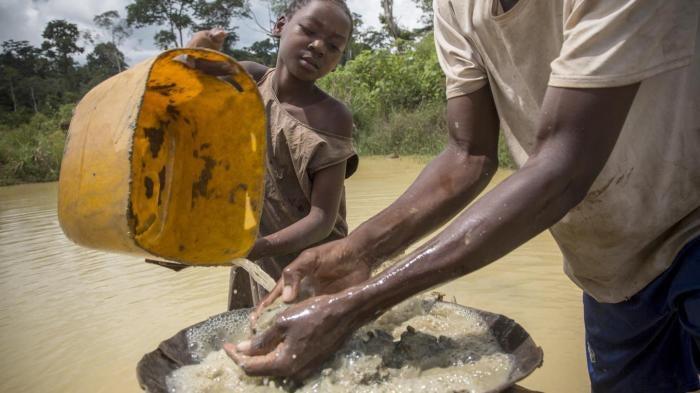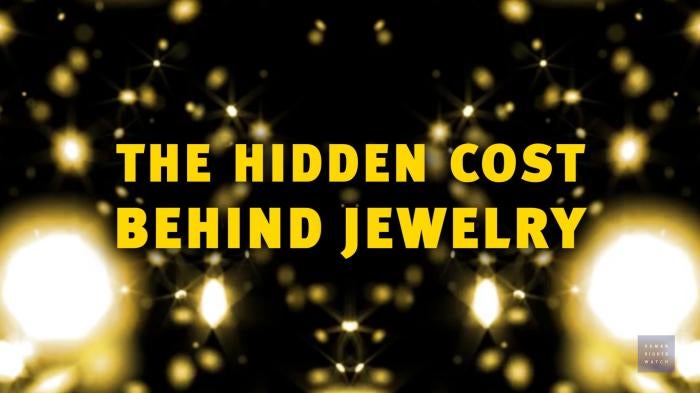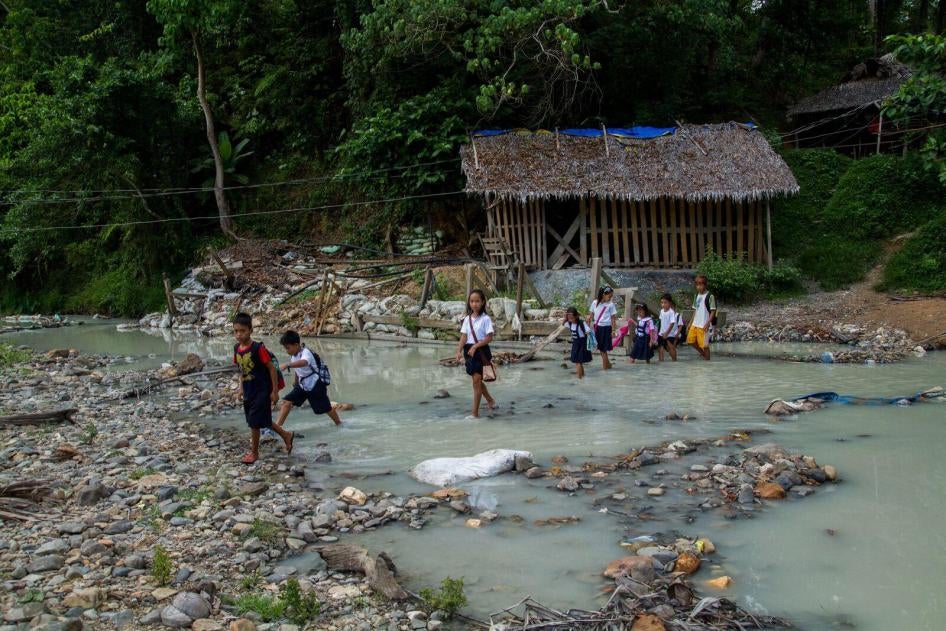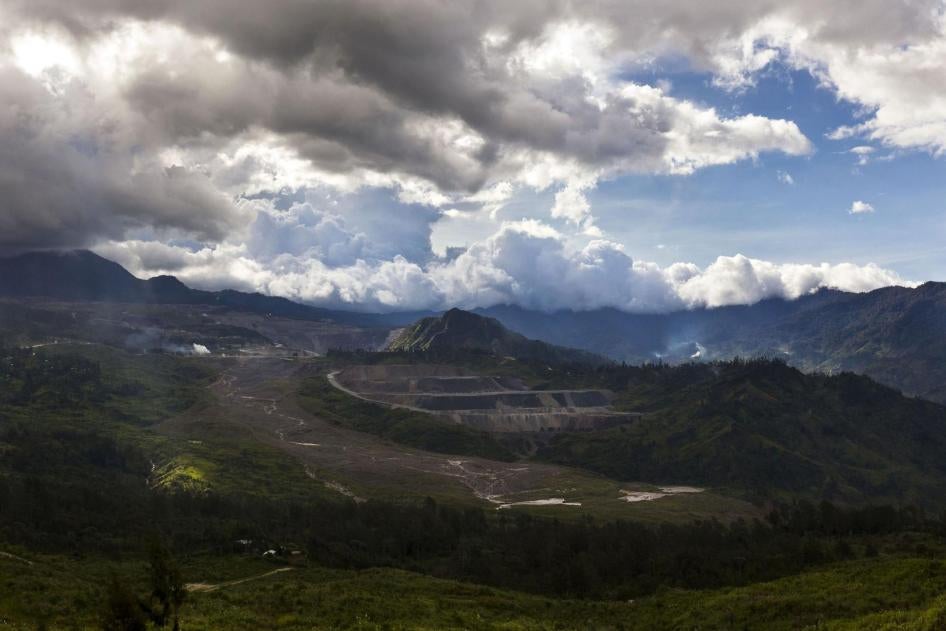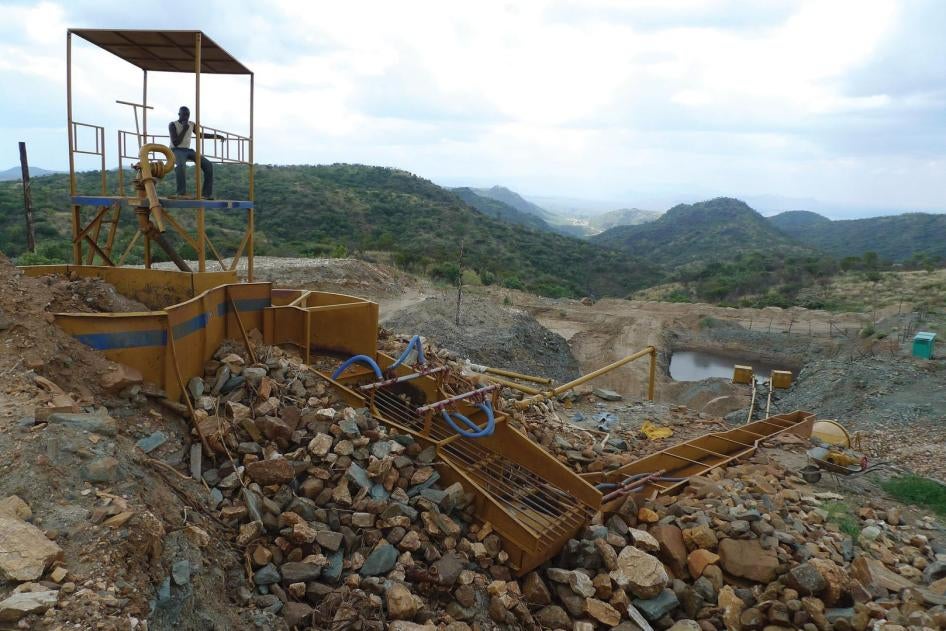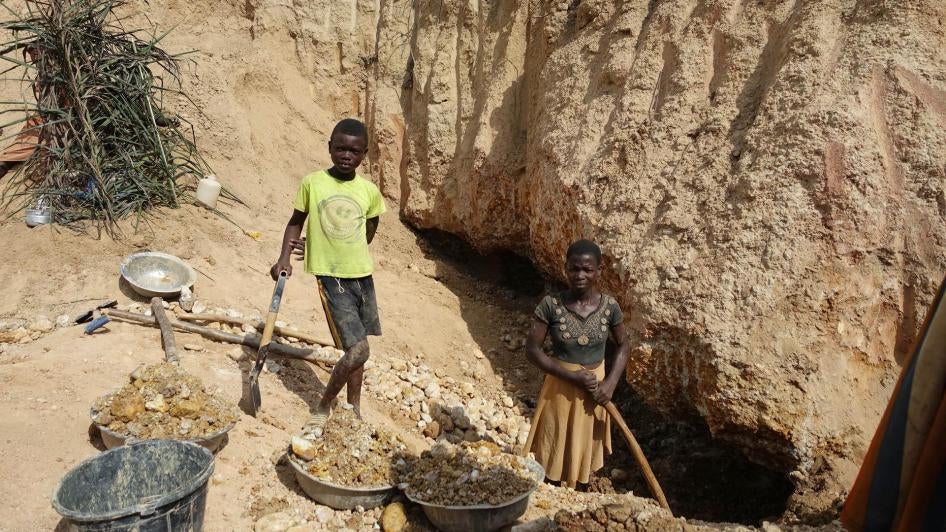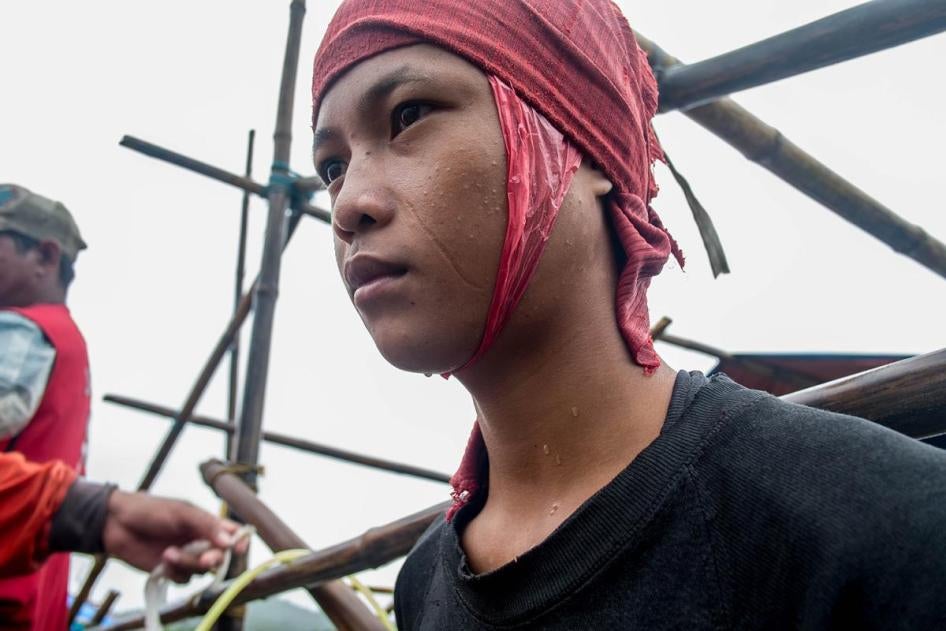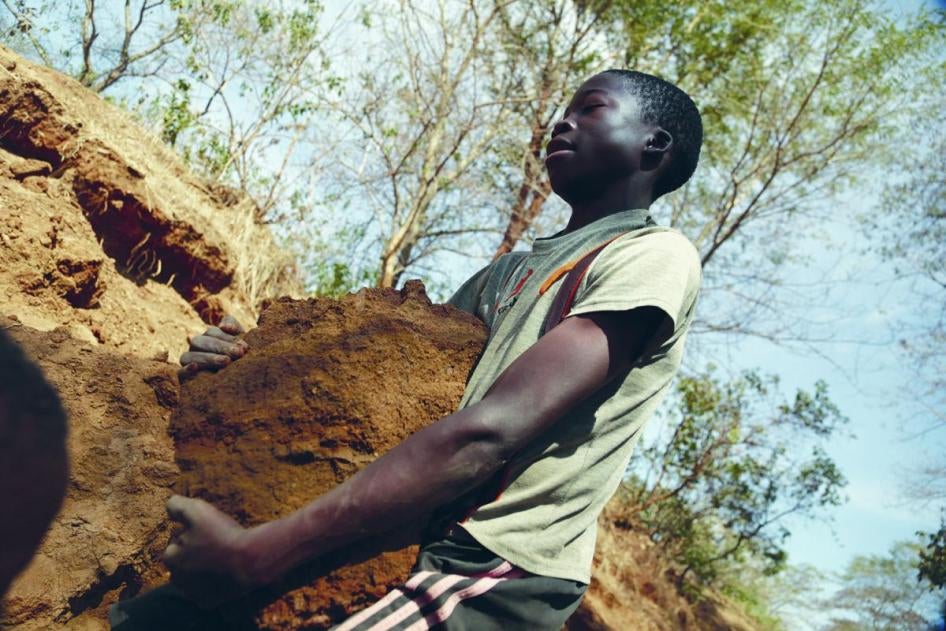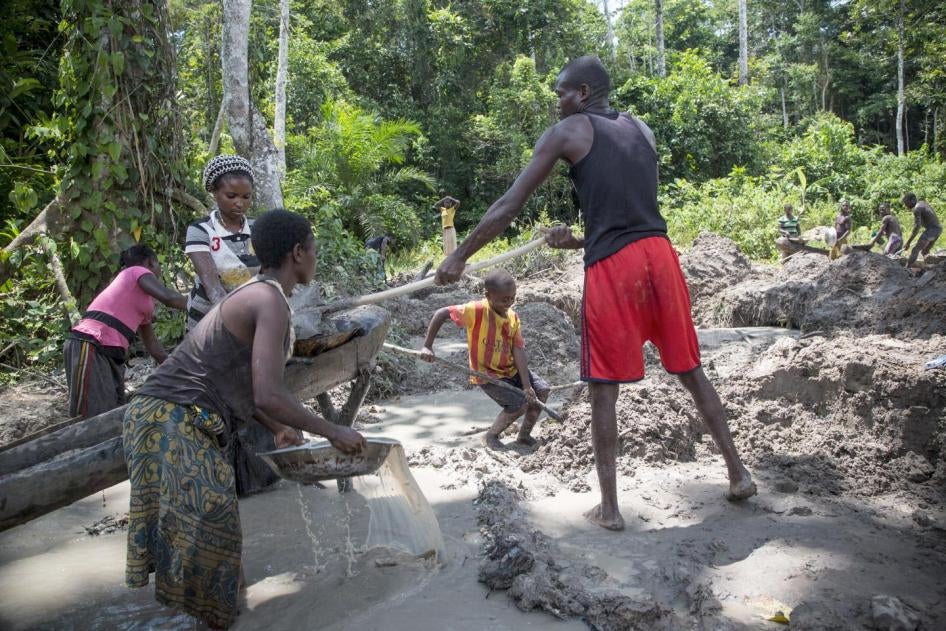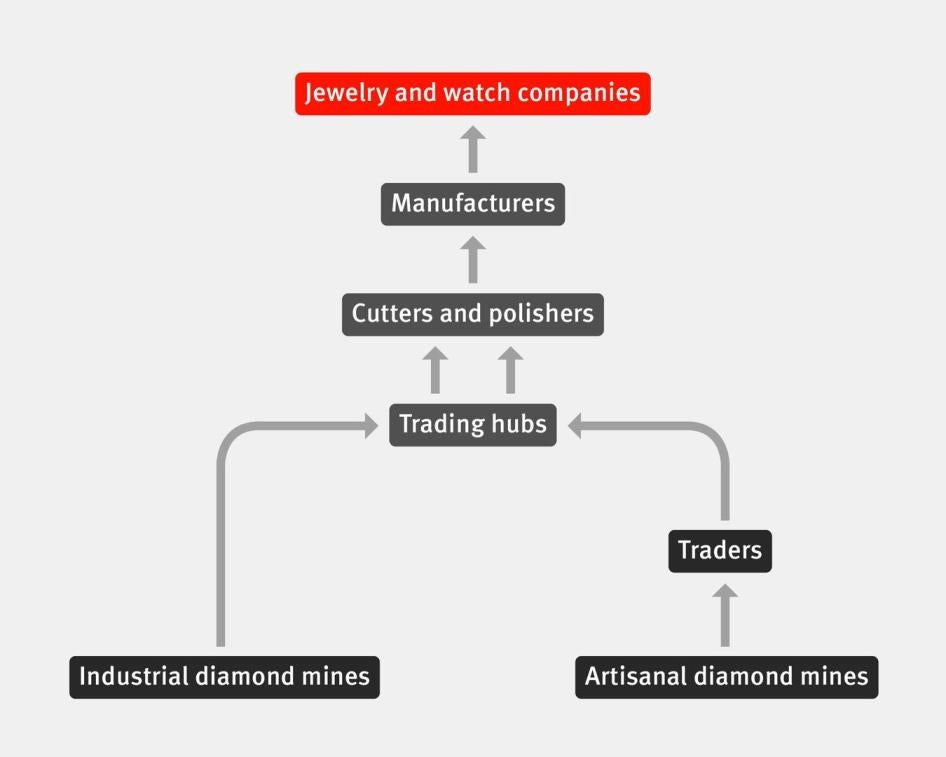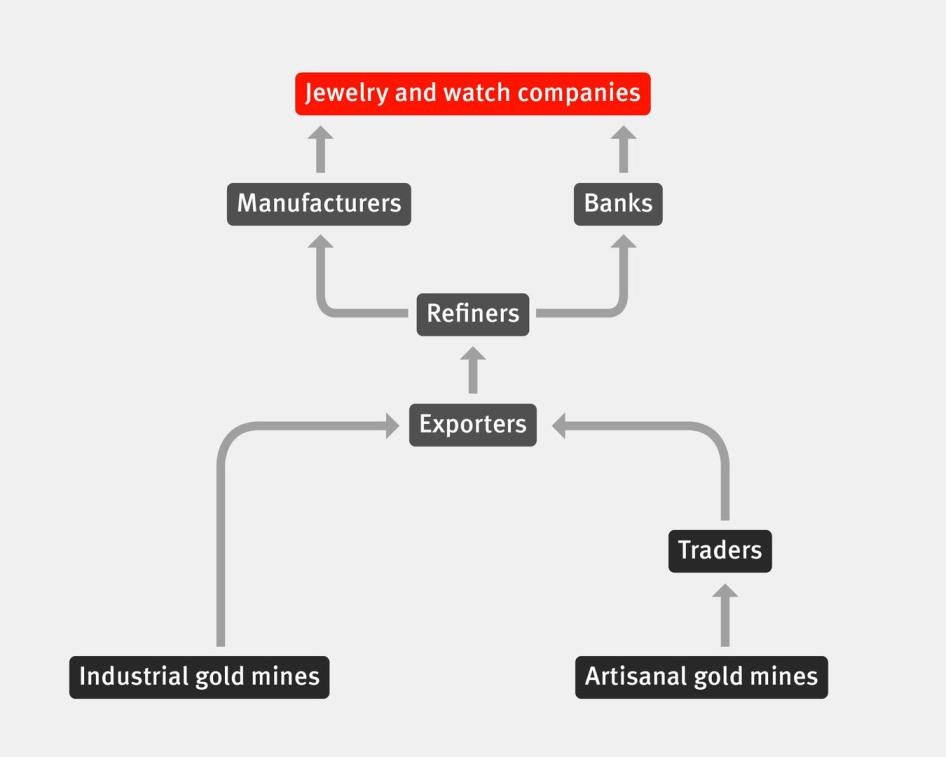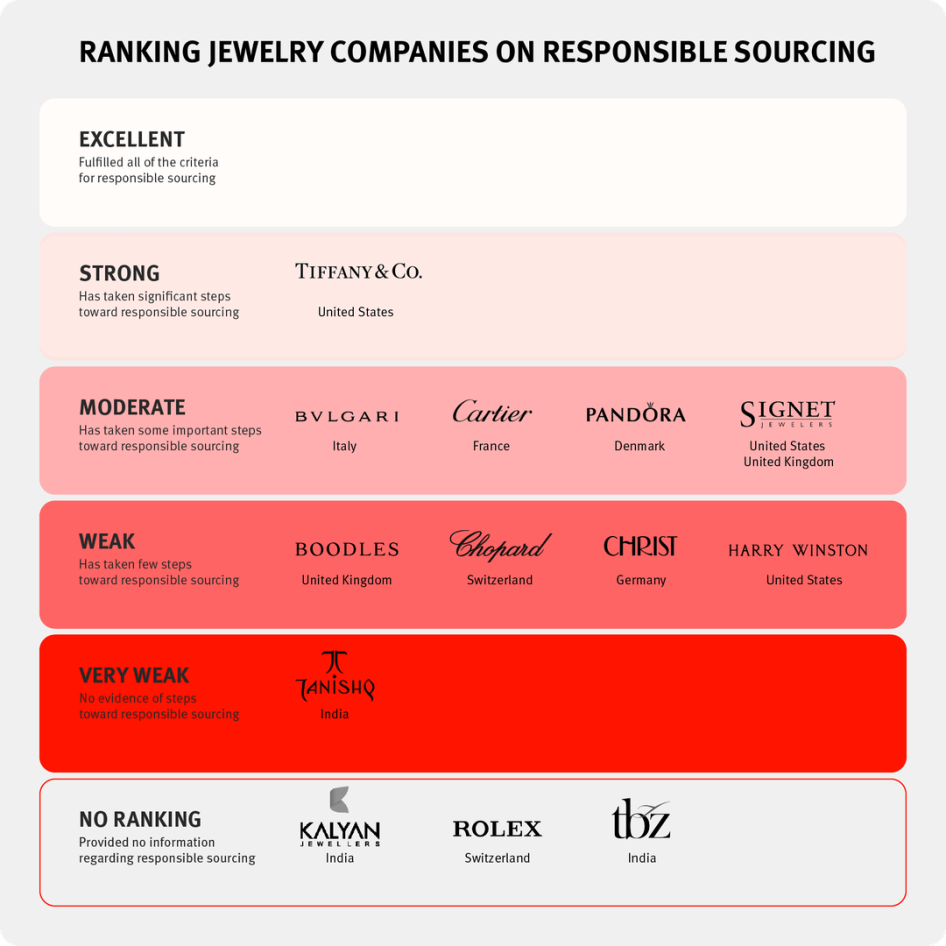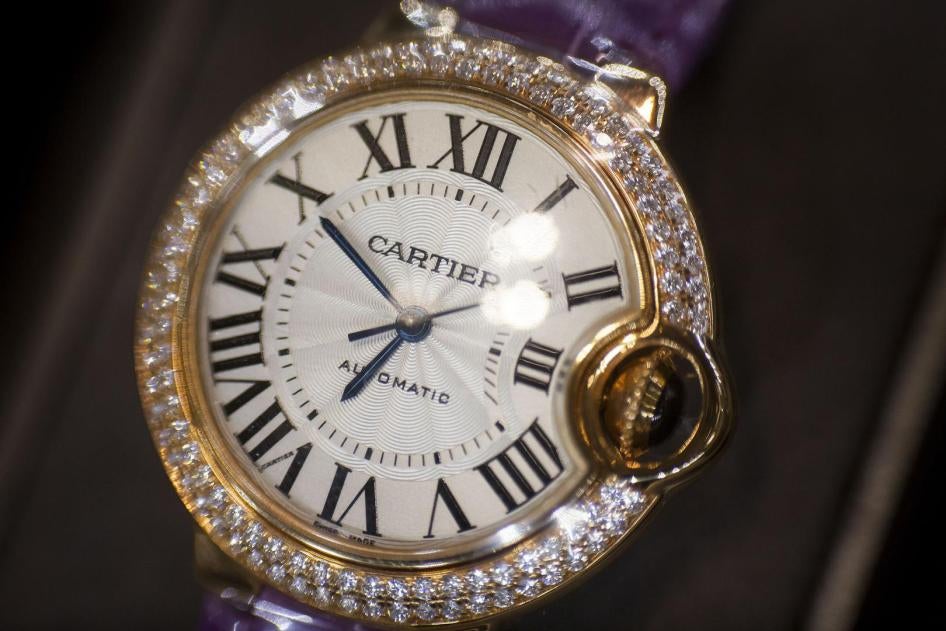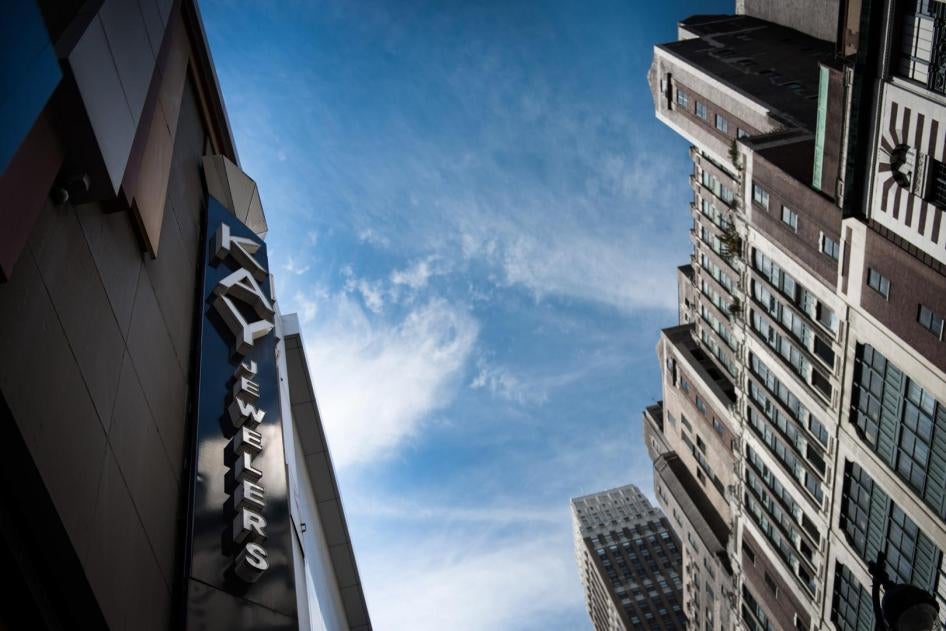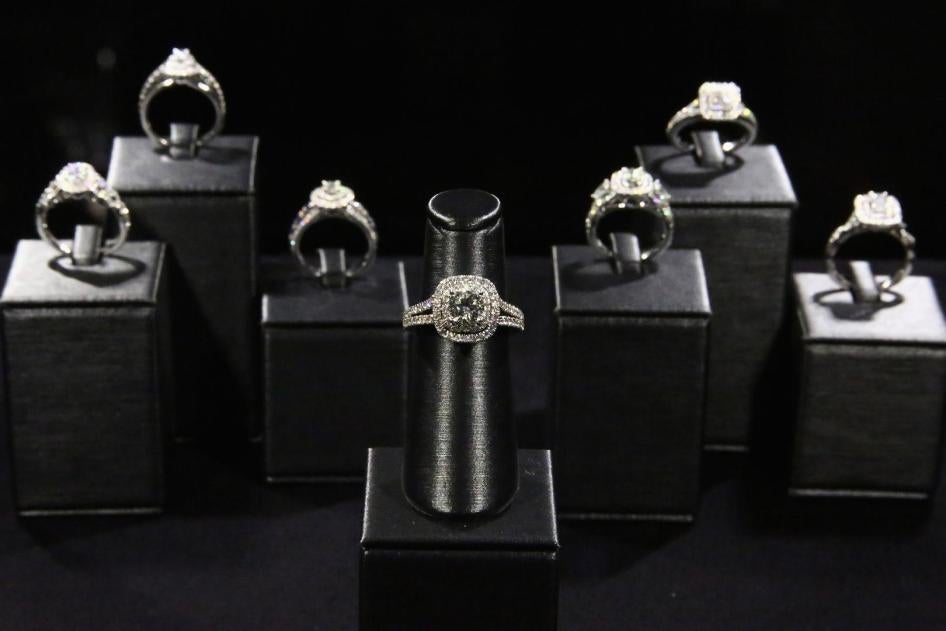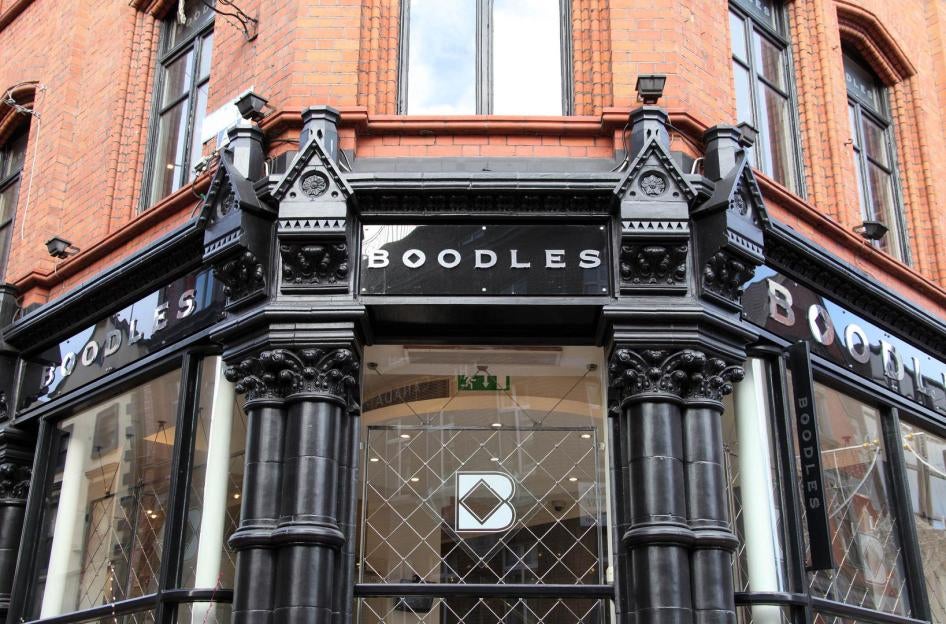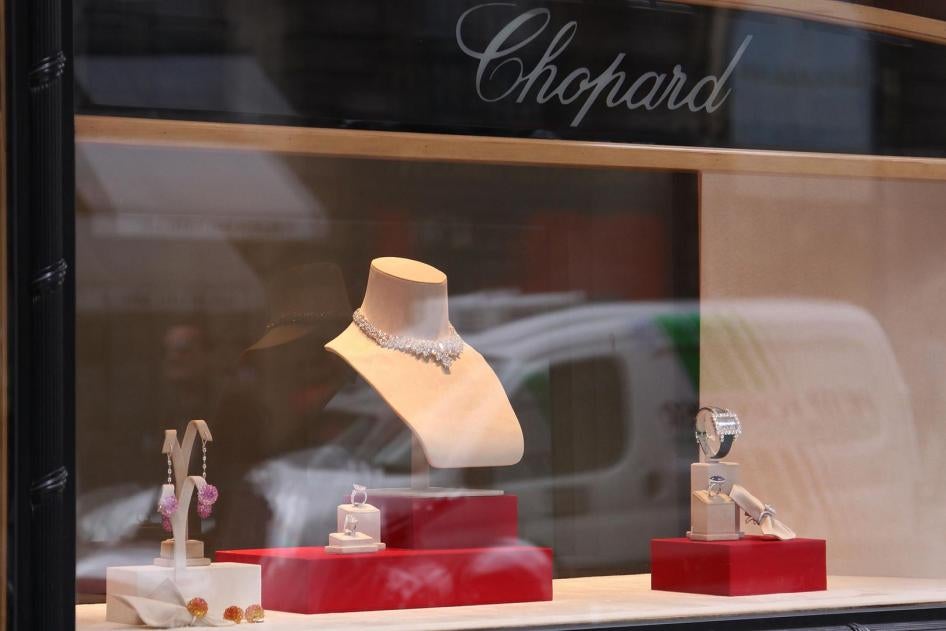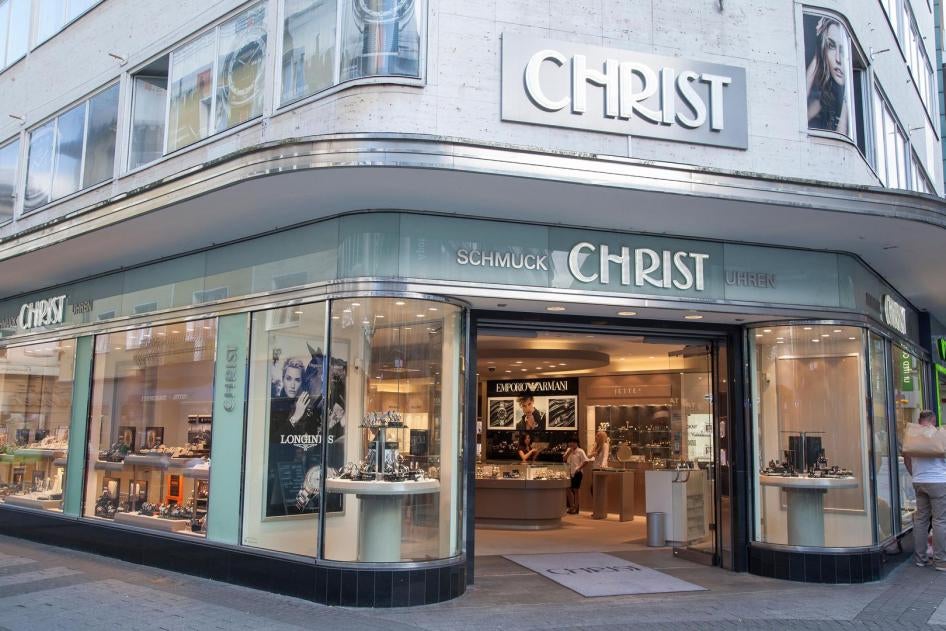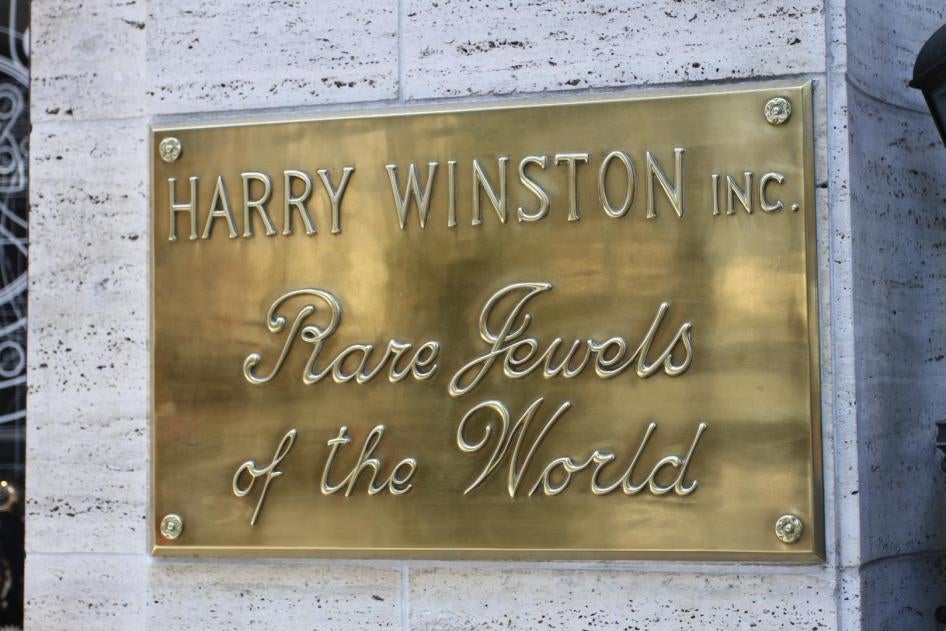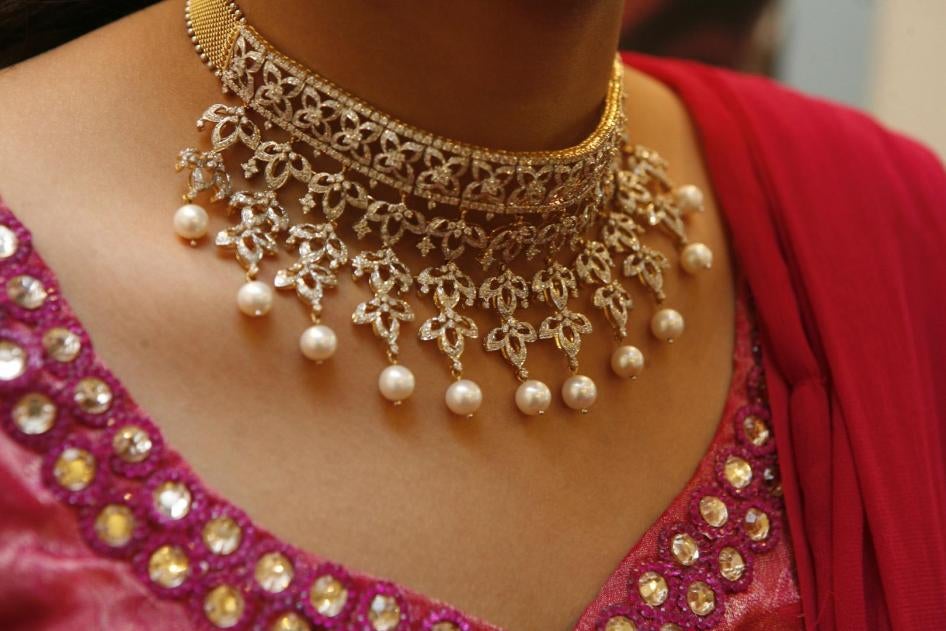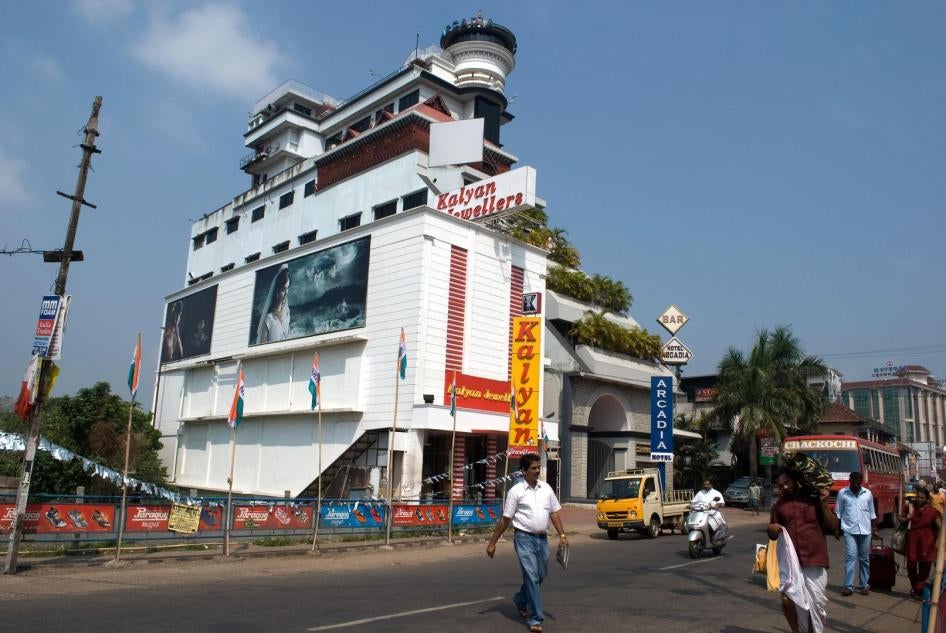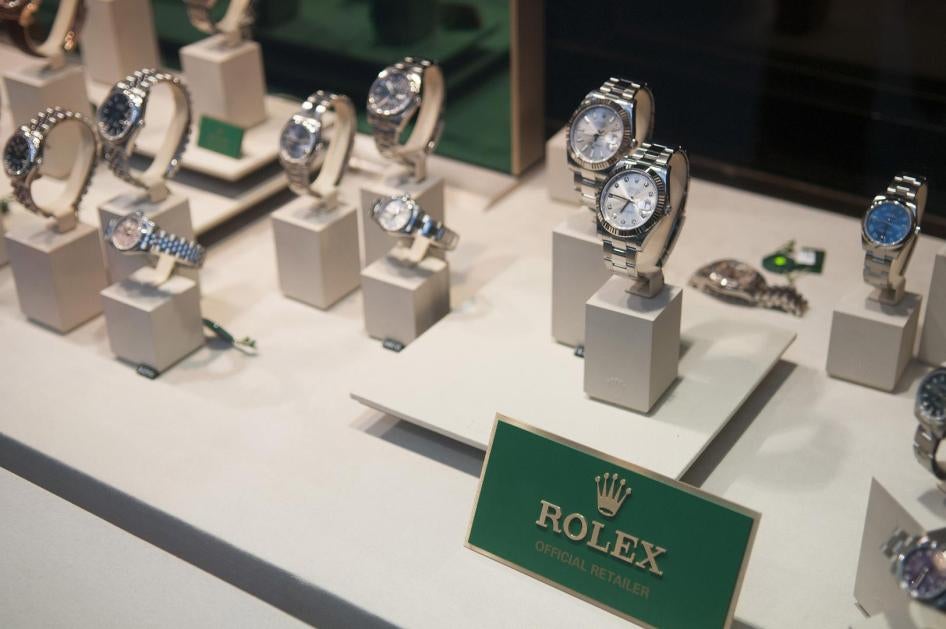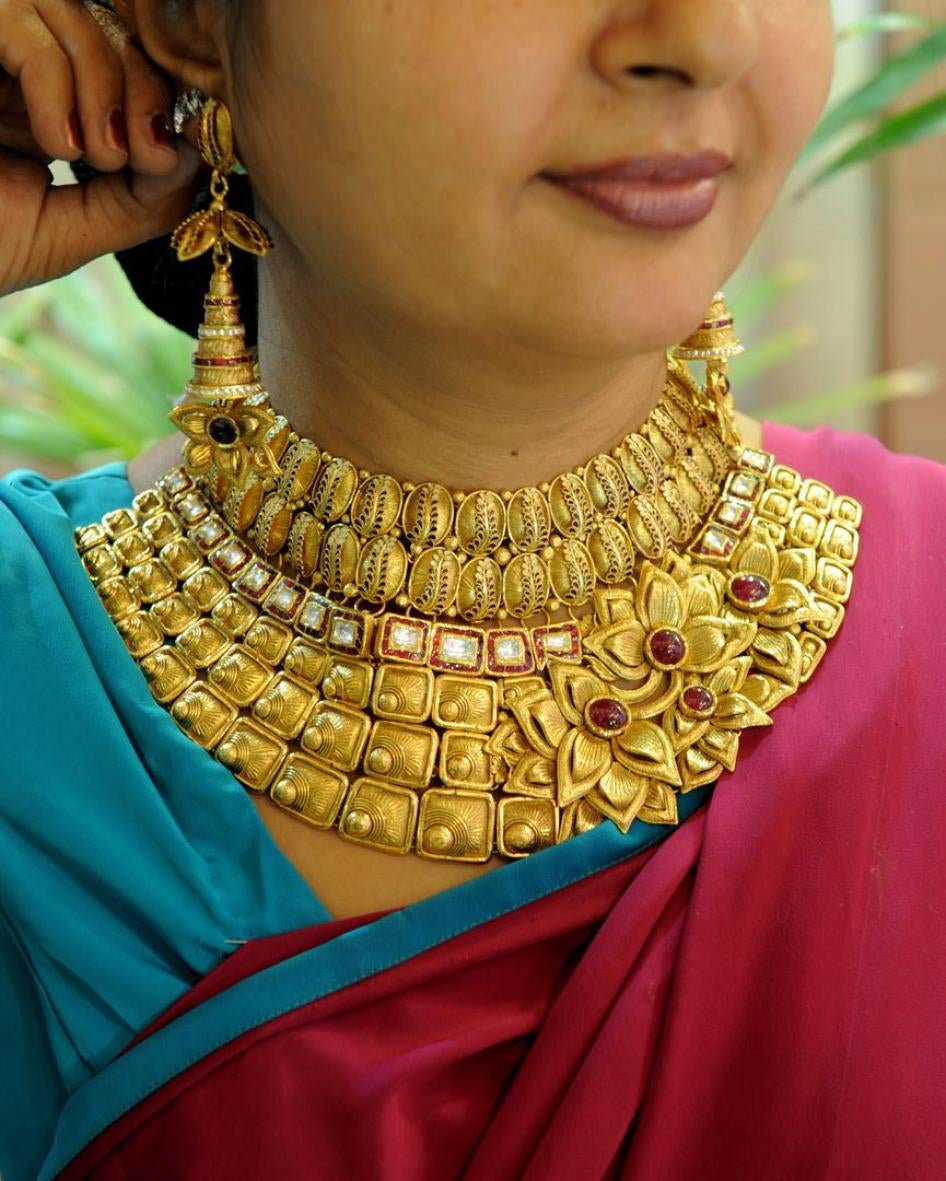Summary
Jewelry and watches denote wealth and status, as well as artistry, beauty, and love. Gold and diamond jewelry in particular are frequently purchased as gifts for loved ones and for special occasions. Globally, about 90 million carats of rough diamonds and 1,600 tons of gold are mined for jewelry every year, generating over US$300 billion in revenue.
The purchase of bridal jewelry, including engagement and wedding rings, has particular emotional and financial significance. In India, for example, weddings generate approximately 50 percent of the country’s annual gold demand. For Valentine’s and Mother’s Day, Americans spend more on jewelry than any other type of gift, purchasing nearly $10 billion of jewelry for the two holidays in 2017.
For millions of workers, gold and diamond mining is an important source of income. But the conditions under which gold and diamonds are mined can be brutal. Children have been injured and killed when working in small-scale gold or diamond mining pits. Indigenous peoples and other local residents near mines have been forcibly displaced. In war, civilians have suffered enormously as abusive armed groups have enriched themselves by exploiting gold and diamonds. Mines have polluted waterways and soil with toxic chemicals, harming the health and livelihoods of whole communities.
Jewelers and watchmakers typically rely on complex supply chains to produce each piece of jewelry or watch. Gold, diamonds, and other minerals and gemstones are mined in dozens of countries around the world, and are then typically traded, exported, and processed in other countries. Processed gold and polished diamonds are then transformed into jewelry in manufacturing plants and artisan workshops, before reaching retailers. By the time a piece of jewelry is offered for sale, it may be very difficult to know the origins of the gold or diamonds it contains, or whether they are tainted by human rights abuses or environmental harms.
Despite this complexity, jewelry companies have a responsibility to ensure that their businesses do not contribute to human rights abuses at any point in their supply chains. Under the United Nations Guiding Principles on Business and Human Rights, an international standard on human rights responsibilities of companies, businesses have to put in place “human rights due diligence”—a process to identify, prevent, mitigate, and account for their own impact on human rights throughout their supply chain. The Organisation for Economic Co-operation and Development (OECD) has developed this approach further in its “Due Diligence Guidance for Responsible Supply Chains of Minerals from Conflict-Affected and High-Risk Areas,” the leading due diligence standard for minerals.
Consumers increasingly demand responsible sourcing too. A growing segment of younger consumers are concerned about the origins of the products they buy, and want to be sure that the jewelry they purchase has been produced under conditions that respect human rights.
In this report, Human Rights Watch scrutinizes steps taken by key actors within the jewelry industry to ensure that rights are respected in their gold and diamond supply chains. The report focuses on the policies and practices of 13 major jewelry brands, selected to include some of the industry’s largest and best-known jewelry and watch companies and to reflect different geographic markets: Boodles (United Kingdom), Bulgari (Italy), Cartier (France), Chopard (Switzerland), Christ (Germany), Harry Winston (United States), Kalyan (India), Pandora (Denmark), Rolex (Switzerland), Signet (United States-based parent company of Kay Jewelers and Zales in the US, Ernest Jones and H. Samuel in the UK, and other jewelers), Tanishq (India), Tribhovandas Bhimji Zaveri Ltd. (TBZ Ltd.)(India), and Tiffany and Co. (US). Collectively, these 13 companies are estimated to generate over $30 billion in annual revenue.
Human Rights Watch first contacted these 13 companies with letters and requested meetings with each company. Ten companies responded. Nine sent written responses. Of those, six companies agreed to meet with Human Rights Watch. Another company met with Human Rights Watch without sending a letter. Three companies did not respond, despite repeated requests. Human Rights Watch analyzed the actions taken by the jewelers based on information provided directly by the companies, as well as publicly available information from company websites and other public sources. We also assessed the governance, standards, and certification systems of the Responsible Jewellery Council (RJC), an industry-led initiative with over 1,000 members, including jewelry manufacturers and retailers, refiners, and mining companies.
Our research found that most of the 13 jewelry companies we contacted directly recognize their human rights responsibilities and have made some efforts to responsibly source their gold and diamonds. However, their practices differ significantly.
Some of the companies scrutinized for this report have taken important steps to address human rights risks in the gold and diamond supply chain. For example, Tiffany and Co. can trace all of its newly mined gold back to one mine of origin and conducts regular human rights assessments with the mine. Cartier and Chopard have full chain of custody for a portion of their gold supply. Bulgari has conducted visits to mines to check human rights conditions. Pandora has published detailed information about its human rights due diligence efforts, including on noncompliance found during audits of its suppliers and steps it is taking to address them. In addition, two companies we contacted have pledged to take specific steps to improve their practices going forward. Boodles has pledged to develop a comprehensive code of conduct for its gold and diamond suppliers, and to make it public. The company has also pledged to report publicly on its human rights due diligence from 2019, and to conduct more rigorous human rights assessments. Christ has pledged to publish its supplier code of conduct and other information on its human rights due diligence efforts in the coming year.
While these are promising signs, we found that most companies still fall short of meeting international standards. While some companies are actively working to identify and address human rights risks in their supply chains, others rely simply on the assurances of their suppliers that their gold and diamonds are free of human rights abuses, without rigorously verifying these claims. Some have made no commitments to responsible sourcing at all. Almost none can identify the specific mines where all of their gold and diamonds originate. Few provide comprehensive public reports on their efforts to responsibly source gold and diamonds.
Based on information provided to us by the companies directly and publicly available information, we assess the company’s responsible sourcing policies and practices as follows:
Excellent (Companies that fulfill all of the criteria for responsible sourcing:)
None
Strong (Companies that have taken significant steps towards responsible sourcing): Tiffany and Co.
Moderate (Companies that have taken some important steps towards responsible sourcing): Bulgari, Cartier, Pandora, Signet
Weak (Companies that have taken few steps towards responsible sourcing):
Boodles, Chopard, Christ, Harry Winston
Very weak (Companies for which there was no evidence of steps towards responsible sourcing): Tanishq
No ranking due to nondisclosure (Companies that provide no information regarding responsible sourcing): Kalyan, Rolex, TBZ Ltd.
Our research also found that many companies are over-reliant on the Responsible Jewellery Council for their human rights due diligence. The RJC has positioned itself as a leader for responsible business in the jewelry industry, but has flawed governance, standards, and certification systems. Despite its shortcomings, many jewelry companies use RJC certification to present their gold and diamonds as “responsible.” This is not enough.
While the industry has a long way to go, some exciting initiatives have emerged in recent years to show that change is possible. The Canadian jeweler Fair Trade Jewellery Co. has recently started to import fully-traceable gold from artisanal mines in the Democratic Republic of Congo. A growing number of small jewelers in the UK and elsewhere are sourcing their gold from artisanal mines in Latin America that are certified under the Fairtrade or the Fairmined gold standard. And a Canadian diamond company, the Dominion Diamond Corporation, has introduced a line of traceable diamonds called CanadaMark, which are independently tracked at every stage from the mine to polished stone.
To move forward, all jewelry companies need to put in place strong human rights safeguards—otherwise, they risk contributing to human rights abuses. In particular, companies should:
- Put in place a robust supply chain policy that is incorporated into contracts with suppliers;
- Establish chain of custody over gold and diamonds by documenting business transactions along the full supply chain back to the mine of origin, including by requiring suppliers to share detailed evidence of the supply chain;
- Assess human rights risks throughout their supply chains;
- Respond to human rights risks throughout their supply chains;
- Check their own conduct and that of their suppliers through independent third-party audits (a systematic and independent examination of a company’s conduct);
- Publicly report on their human rights due diligence, including risks identified;
- Publish the names of their gold and diamond suppliers;
- And source from responsible, rights-respecting artisanal and small-scale mines.
To be credible, the Responsible Jewellery Council should become a true multi-stakeholder body by giving civil society and industry representatives equal decision-making power at all levels and strengthening its standards and auditing practices to set a higher bar for responsible sourcing practices by the industry.
Cases
Ghana
A Human Rights Watch team met “Peter,” age 15, at an artisanal and small-scale gold mine in Odahu, Amansie West district, Ghana’s Ashanti region in March 2016. Peter and several other children were digging ore out of deep, unsecure pits that were placed underneath a mass of hard rock. Peter also used toxic mercury, without being aware of the health risks. Peter described his life:
“I am working at the old Chinese mining site. I bring the load up from the ground, I dig. I also do the washing [processing of the gold ore]. I use mercury, and get it from the gold buyer… I started about two years ago…. I use the money [I earn] to buy food and clothes, and give some to my mother. I am here every day, from 6 a.m. to 5 p.m…. I dropped out of school in P5 [5th grade of primary school]. I was unable to buy my things for school…. I wish I could have stayed in school.”
Philippines
In Jose Panganiban, in the Philippines, “Joseph,” 16, mines gold underwater, sometimes diving for hours, breathing through a tube. He told Human Rights Watch in November 2014:
I started working when I was 12. Sometimes I help pull out the bags, and sometimes I go underwater. It’s just like digging with a shovel, and putting it in a sand bag. [To breathe] I use the compressor…. I bite the hose and release it whenever I need air, inhale, and exhale through my nose…. At first, it was hard to think about going down… I don’t use goggles. I basically don’t use my eyes. I use my hands to look for the passage, the canal…. Sometimes you have to make it up fast, especially if you have no air in your hose if the machine stops working. It’s a normal thing [for the compressor to stop working]. It’s happened to me.I get a skin disease. It’s not itchy, and it doesn’t hurt. But the color of the skin changes. It gets red. I get it on my face…. I can smell [the fumes from the compressor] when they are transferring fuel. I can smell it because it travels down the hose…. If I work so hard underwater, I get tired.
Tanzania
In Chunya district, Tanzania in December 2012, Human Rights Watch interviewed “Rahim,” a 13-year-old boy who was involved in a mining accident. Rahim described his harrowing experience:
“I was digging with my colleague. I entered into a short pit. When I was digging he told me to come out, and when I was about to come out, the shaft collapsed on me, reaching the level of my chest … they started rescuing me by digging the pit and sent me to Chunya hospital.”
The accident, Rahim told Human Rights Watch, knocked him unconscious and caused internal injuries. He remained in the hospital for about a week and over a year later still occasionally felt pain in his abdomen.
Central African Republic
In November 2016, a resident from Bria, Central African Republic, told Human Rights Watch that fighters from two factions of the Seleka armed group—both of which have committed numerous war crimes—fought over control of roads leading to diamond mines around Kalaga, in the eastern Central African Republic. The two armed groups are the Popular Front for the Renaissance in the Central African Republic (Front Populaire pour la Renaissance de la Centrafrique, FPRC) and the Union for Peace in the Central African Republic (l'Union pour la Paix en Centrafrique, UPC). Human Rights Watch has documented serious crimes committed by these groups. Fighters from one of the factions, the Popular Front for the Renaissance in the Central African Republic deliberately targeted civilians from the Peuhl ethnic group, including two injured Peuhl men who were receiving treatment at the main hospital in the town of Bria, Haute Kotto province. FPRC fighters killed the two men outside the hospital’s main entrance. An injured Peuhl witnessed the killings and told Human Rights Watch:
“We were on the hospital grounds, but not yet in the buildings. Men came to take us. They took two men, Amadou and Halidou, outside and killed them with guns and machetes.”
The FPRC eventually gained access to the mines in Kalaga. Rebel commanders told Human Rights Watch that access to diamond mines was crucial to their operations.
I. Introduction
The Supply Chains for Gold and Diamonds
The Diamond Supply Chain
Approximately 130 million carats of rough diamonds are mined every year, including both gem-quality and industrial diamonds; about 70 percent, or 90 million carats, are gem quality.[1] Russia, Botswana, Canada, and Australia are the world’s largest diamond producers, and the 10 largest mines account for over half of the world’s diamond production.[2] Approximately 20 percent of gem-quality diamonds come from artisanal mines.[3]
The diamond industry is dominated by two giant mining companies, ALROSA, a Russian company, and De Beers, which operates mines in Botswana, Canada, Namibia, and South Africa. These two companies account for over half of the world’s rough diamond sales. A handful of other mining companies–Rio Tinto, Dominion, and Petra–each have smaller shares of the diamond market.[4]
After rough diamonds are mined, they typically are exported to diamond trading hubs (or exchanges,) where they are sorted according to shape, color, size, and carat. The largest diamond trading hubs are in Antwerp and Dubai. Diamonds may be traded multiple times before they are sent to cutters and polishers. They may also be sent both in rough and polished form between several jurisdictions before being purchased and made into jewelry and watches; sometimes this involves mixing of shipments.[5] At least 70 percent of diamonds are cut and polished in India, largely because of low labor costs, while approximately 20 percent are cut and polished in China.[6] Once diamonds are cut and polished, they are sent to jewelry manufacturers, and finally, to retailers. The United States is the largest market for diamond jewelry, accounting for over 40 percent of the world’s demand for polished diamonds.[7]
Mining companies often do not disclose the mines of origin for the diamonds they sell. For example, both De Beers and ALROSA, the two largest diamond producers, aggregate diamonds from multiple mines before selling them to their customers.[8] De Beers sells rough diamonds from eight mines located in four countries (Botswana, Canada, Namibia, and South Africa). The company states that it provides clients with “complete and unequivocal assurance” that its diamonds are responsibly sourced from its own or joint venture mines, but does not identify the mine or country of origin for individual diamonds.[9]
The Gold Supply Chain
Gold is mined in around 80 countries, with approximately 3,200 tons produced every year.[10] The largest producers are China, Australia, Russia, and the US.[11] Most gold comes from large, industrial mines, though 15 to 20 percent of the world’s gold comes from small-scale or artisanal mines, primarily in Africa, Asia, and Latin America.[12] Jewelry accounts for over 50 percent of the world’s gold demand, an estimated 1,600 tons of gold for 2016.[13]
The world’s largest industrial gold mining companies include Barrick Gold Corporation (Canada), Newmont Mining (US), AngloGold Ashanti Limited (South Africa), Goldcorp Inc. (Canada), and Kinross Gold Corporation (Canada).[14] These companies operate large-scale mining operations that are highly mechanized. Artisanal and small-scale mining, by contrast, is labor intensive, with simple machinery.
Gold from industrial mines may be exported directly to refiners, while artisanal gold may pass from one trader to another before being exported for refining. Gold refiners play a crucial role in the gold supply chain. Because the vast majority of the world’s gold passes through a small number of refiners, these companies are sometimes called the “choke point” of the gold supply chain.[15] For example, just four companies based in Switzerland—Valcambi, Metalor, Produits Artistiques Métaux Précieux (PAMP), and Argor-Heraeus—refine more than half of the world’s gold.[16]
Once gold is refined, it is sold to banks, manufacturers, jewelry and watch companies, electronics companies, or other businesses. Jewelry companies may source their gold directly from refiners, or from manufacturers, banks, or international gold traders. China and India are the largest markets for gold jewelry, representing over 50 percent of global jewelry demand.[17]
Human Rights Abuses in the Gold and Diamond Supply Chain
Around the world, millions of people work in gold and diamond mining. The vast majority of them—an estimated 40 million people—work in artisanal and small-scale mines, which operate with little or no machinery and often belong to the informal sector.[18] Artisanal and small-scale mining is often an important source of livelihood for these populations and accounts for 15 to 20 percent of the world’s gold. Industrial mining operations are also major employers; around one million people work in industrial gold mining operations.[19]
However, mining has also contributed to human rights abuses. Human Rights Watch and other civil society groups have documented a wide range of human rights abuses in the context of gold and diamond mining, including labor rights abuses, conflict-related abuses against civilians, violations of the right to environmental health, and other violations.
The Worst Forms of Child Labor
An estimated one million—and possibly many more—children work globally in artisanal and small-scale mining, in violation of international human rights law, which defines work underground, underwater, or with dangerous substances as hazardous and, therefore, among the worst forms of child labor and prohibited for children.[20] These prohibitions are clearly reflected in the domestic laws of many countries where hazardous child labor nonetheless continues to persist. Children who work in mining are often exposed to extreme danger. Many children work in deep, unstable pits; some have been injured or even killed in accidents. Children suffer respiratory disease from inhaling dust, pain and back injury from the lifting of heavy rocks, and other health conditions from mining. In artisanal and small-scale gold mines, children may be exposed to toxic mercury, which is used for gold processing, and can cause lifelong brain damage and other irreversible conditions.
Human Rights Watch has documented the use of hazardous child labor in gold or diamond mining in Ghana, Mali, Nigeria, the Philippines, Tanzania, and Zimbabwe.[21] Other independent investigations have documented hazardous child labor in gold mines in Burkina Faso, Uganda, the Democratic Republic of Congo, and Indonesia.[22]
Forced Labor and Human Trafficking
In some gold and diamond mines, adults and children have become victims of forced labor and human trafficking. Forced labor is understood as a situation where an individual works involuntarily and under “menace of penalty.”[23] Those who attempt to leave may face violence and other abuse. Human trafficking occurs when a person is recruited or transported by force, threat, or deception for the purpose of exploitation.[24]
Human Rights Watch found that in Eritrea, for example, conscripts for the national service program were forced to work indefinitely for a subcontractor of a Canadian gold mining company. Workers have initiated a law suit against the company.[25] In Zimbabwe, from 2008 to 2014, workers were forced by the military to work in diamond mining.[26] Other studies have documented forced labor in gold mines in Peru and the Democratic Republic of Congo.[27]
Environmental Harm
Gold and diamond mining operations have sometimes caused serious environmental damage and threatened people’s rights to health, water, food, and a healthy environment.[28] For example, large-scale industrial mines have caused dangerous pollution through the dumping of tailings (mine residue), leakages, and accidents.[29] An example is the 2014 mining disaster at the Canadian Mount Polley gold (and copper) mine, in which toxic tailings were unleashed into a lake and other waterways due to a tailings pond failure.[30]
Artisanal and small-scale mining has also caused environmental harm. For example, small-scale gold mines emit annually an estimated 1,400 tons of mercury, a toxic metal that is used in gold processing but causes damage to the nervous system and can kill. The resulting pollution of air, water, and soil constitutes a global environmental threat and has resulted in negative health effects for workers and local communities living near such gold mines.[31] In Nigeria, artisanal gold mining has caused unintentional releases of lead that has killed over 400 children.[32]
Land Rights and Indigenous People’s Rights Violations
In some cases, international mining companies and governments have abused the rights of local residents when clearing land for exploration and mining.[33] In Zimbabwe, for example, the government has been accused of forcibly displacing villagers to make way for diamond mining in Marange.[34]
Mining operations have also caused violations of the rights of indigenous peoples. International gold companies in Uganda, for example, failed to secure free, prior, and informed consent from indigenous Karamojong communities in Uganda before doing exploration, in violation of international human rights standards.[35] Amnesty International reported that the Mount Polley mining disaster in Canada negatively affected the traditional livelihood of indigenous peoples—salmon fishing—and destroyed sacred lands and traditional medicines.[36] When indigenous people in some countries have protested against mining operations, they have sometimes faced repression and even been killed.[37]
Armed Conflict Violations, Including Killings and Sexual Violence
Gold and diamond companies have also been directly linked to violations of international humanitarian law, which applies to situations of armed conflict. In particular, gold and diamond mining and trade have helped finance violent and abusive armed groups, including through money laundering.
For example, investigations by Human Rights Watch and other nongovernmental organizations have documented how the illegal gold trade in the Democratic Republic of Congo has benefited armed groups responsible for horrific crimes against civilians, including massacres and systematic sexual violence.[38] Other research has shown the link between diamond mining and human rights abuses in conflict-torn Central African Republic. Here, armed groups responsible for killings of civilians and other war crimes benefited from the diamond trade, and competing rebel factions have attacked diamond mining areas to obtain control over the business and loot diamond dealers. In November 2016, while fighting for control over roads leading to diamond mines around Kalanga, one faction deliberately targeted and killed Peuhl civilians in the area.[39] Gold mining has also helped fund armed groups in Colombia.[40]
Abusive government armed forces also have benefited from mining. For example, in Zimbabwe, army brigades were sent to the diamond mines to ensure access to mining revenue by senior members of the ruling party and the army itself between 2008 and 2014.[41] In Angola during 2015, soldiers and private security guards were accused by human rights activists of torturing and killing civilians in their quest to control diamond mining operations.[42]
II. Existing Standards–And Why They Are Not Enough
Companies have human rights responsibilities. These responsibilities have been spelled out in the United Nations Guiding Principles on Business and Human Rights, an international standard that was endorsed by the UN Human Rights Council in 2011 and has since been widely recognized by companies. Under the Guiding Principles, companies are expected to take proactive steps to ensure that they do not cause or contribute to human rights abuses within their global operations, and respond to human rights abuses when they occur. This responsibility extends beyond companies’ direct operations to include their global supply chains.
The Guiding Principles require companies to put in place human rights due diligence—that is, a process to identify, prevent, mitigate, and account for companies’ impacts on human rights—throughout their supply chain.[43] Businesses should monitor their human rights impact on an ongoing basis and have processes in place to remediate adverse human rights impacts they cause or to which they contribute.[44]
Some companies engage in philanthropy or social programs outside their own operations as part of their commitments to corporate social responsibility. Such charitable endeavours are largely unrelated to the question of whether a company is living up to its human rights responsibilities under the UN Guiding Principles.
In addition to the UN Guiding Principles, several global standards have been developed specifically for precious metals and stones, including the Due Diligence Guidance for Responsible Supply Chains of Minerals from Conflict-Affected and High-Risk Areas by the Organisation for Economic Co-operation and Development (OECD), the Kimberley Process Certification Scheme, and two standards by the Responsible Jewellery Council.
While the UN Guiding Principles and industry-specific standards can play a role in guiding companies towards responsible sourcing, they all suffer from a number of weaknesses, notably their voluntary nature and a lack of strong monitoring and enforcement mechanisms. Many voluntary initiatives are also undermined by poor and intransparent audits.
Very few countries have laws requiring companies to conduct mandatory human rights due diligence in their supply chain. In 2010, the United States passed conflict minerals legislation, in section 1502 of the Dodd-Frank Act, requiring companies to conduct due diligence for minerals originating from the Democratic Republic of Congo and surrounding countries. However, in June 2017, the US House of Representatives voted to repeal this provision, and in September, approved a bill that would cut funding for implementation and enforcement of the provision; its future now depends on the decision by the US Senate.[45] The European Union has passed a Minerals Regulation that will enter into force from 2021. It will oblige companies importing gold, tin, tungsten, and tantalum into the European Union to conduct due diligence to ensure that they are not contributing to conflict-related abuses or other violations.[46]
OECD Due Diligence Guidance – A Key Standard, Poorly Implemented
The most widely accepted standard in the precious minerals sector is the OECD’s “Due Diligence Guidance for Responsible Supply Chains of Minerals from Conflict-Affected and High-Risk Areas.”[47] It builds on the concept of human rights due diligence developed in the UN Guiding Principles on Business and Human Rights—i.e. a process to identify, prevent, mitigate, and account for a company’s impact on human rights throughout their supply chain. The OECD Guidance lays out five steps for risk-based due diligence: 1) strong management systems, including systems to establish chain of custody;[48] 2) identification and assessment of risks in the supply chain; 3) a strategy to respond to identified risks; 4) third-party audits of supply chain due diligence; and 5) public reporting on supply chain due diligence.
The OECD Due Diligence Guidance applies to the sourcing of all minerals (including diamonds) and implicates a broad range of human rights. It is not limited to conflict regions but applies to all areas that are “high-risk,” such as areas of political instability, repression, institutional weakness, insecurity, collapse of infrastructure, widespread violence, violations of national or international law, or “other risks of harm to people.”[49] The Guidance also applies to all actors in the supply chain; for gold, it distinguishes between “upstream” companies such as mines, gold traders in the country of origin, and international gold refiners, and “downstream” companies, such as international gold traders, bullion banks, jewelers, and other retailers.[50] The standard has inspired a number of other standards for specific regions, actors, or minerals.[51]
However, the OECD Due Diligence Guidance is voluntary and suffers from a lack of monitoring and implementation. States have committed to help put in place the Guidance, but failed to put in place mechanisms to track implementation—or lack thereof—by companies in their country.[52] Civil society groups have found that companies often fail to put the OECD Due Diligence Guidance into practice.[53]
The OECD Due Diligence Guidance requires all companies in a supply chain, including jewelers and watch companies, to conduct due diligence on their suppliers when sourcing from conflict-affected and high-risk areas. But in practice, this often does not happen. Most of the companies assessed for this report told Human Rights Watch that they did not request detailed information from suppliers on their due diligence and the human rights issues identified. As a result, they could not undertake robust and meaningful risk management.[54]
The Kimberley Process—An Inadequate Model
The Kimberley Process Certification Scheme (KPCS) is the most prominent international standard with regards to diamonds.[55] The KPCS is a government-led international certification scheme, launched in 2003 to prevent trade in “conflict diamonds,” which it narrowly defines as rough diamonds used by rebel movements to finance wars against legitimate governments. Under the KPCS, member states have to set up an import and export control system for rough diamonds. The scheme requires documentation of the country of origin, but not of mines of origin.
The Kimberley Process suffers from a number of weaknesses.[56] First, it relies on an indefensibly narrow “conflict diamond” definition that only focuses on abuses perpetrated by rebels, ignoring those of state actors or private security firms. For example, the Kimberley Process has authorized exports of Angolan and Zimbabwean diamonds despite their being mined under highly abusive conditions.[57] Second, it applies only to rough diamonds, allowing stones that are fully or partially cut and polished to fall outside the scope of the initiative. Many diamond shipments that pass through trading hubs are also mixed with diamonds from other countries of export, thereby rendering the diamonds untraceable to either their initial country or mine of origin. Third, over time the Kimberley Process has proven itself reticent to impose sanctions on countries found noncompliant with Kimberley Process minimum requirements, other than in the most egregious and indisputable instances such as in war-torn Central African Republic. Finally, the World Diamond Council’s System of Warranties, meant to support the KPCS, relies on written or oral assurances by diamond suppliers, rather than independent and transparent monitoring.
Due to these weaknesses, civil society groups have suggested that the OECD’s Due Diligence Guidance—which is not limited to conflict areas—become the core standard for the diamond sector.[58] Industry groups, including jewelers like Signet and Tiffany and Co., have also stated publicly that the mandate of the Kimberley Process is too narrow, and should be expanded to include non-conflict-related abuses.[59] However, spokespeople for the diamond industry have been reluctant to explicitly endorse the OECD Due Diligence Guidance, and focused instead on improving the System of Warranties.[60]
The Responsible Jewellery Council—A Weak Assurance
The Responsible Jewellery Council (RJC) brings together more than 1,000 companies in the jewelry industry, including jewelers, manufacturers, refiners, mining companies, and others. It was founded in 2004 by a small group of 14 companies and trade associations interested in increasing consumer confidence that the jewelry they purchase is produced responsibly.[61] RJC members commit to and are audited against the Code of Practices, a standard that outlines responsible business practices for the jewelry supply chain; companies can also join an additional optional standard, the Chain-of-Custody Standard. Membership of the RJC, however, is no guarantee that a company’s jewelry is responsibly sourced.[62] The RJC’s governance, standards, and system of audits are flawed, allowing companies to be RJC-certified even if they fail to meet basic human rights standards.
The RJC board is composed solely of 25 industry representatives from different positions in the supply chain, from mine to retail.[63] The board appoints the chief executive officer, approves new or revised RJC standards and certification models, and takes other key decisions. The RJC consults civil society and other actors and includes civil society representatives on its standard-setting committee, but is essentially an industry body.[64] Its decision-making bodies do not include consumer groups, representatives of mining communities (for example, organizations addressing land rights or environmental harms), trade unions or miners’ associations, or human rights nongovernmental organizations (NGOs).
In late 2017, the RJC was reviewing both its standards; the new version of the Code of Practices is expected to include more specific requirements for human rights due diligence as spelled out in the OECD Due Diligence Guidance. Reform may be particularly urgent for RJC member companies now, as the European Union has made clear that it will recognize only refiners operating according to OECD-aligned standards as “responsible” for its minerals regulation entering into force in 2021.[65]
The Code of Practices
The RJC requires all its members to comply with its Code of Practices, a standard that addresses human rights, labor rights, environmental impact, and mining practices in the jewelry supply chain. In order to be certified against the Code, a company needs to undergo an independent audit that confirms the company is in compliance.
The Code of Practices requires companies to have a human rights due diligence process that seeks to identify, prevent, mitigate, and account for human rights impacts, in line with the UN Guiding Principles on Business and Human Rights. However, the Code of Practices provides little detail on how supply chain due diligence should be implemented. It makes no reference to the OECD Due Diligence Guidance—the international standard for due diligence in the minerals sector—and provides no detail on what steps companies should take to conduct due diligence themselves, or what evidence companies should require from their suppliers in this regard.[66] According to an RJC auditor, suppliers only need to pledge that they conduct strong human rights due diligence, but do not provide any evidence for this.[67] Neither does the Code of Practices require jewelers—or other downstream companies—to have traceability or chain of custody of their gold or diamonds.[68] The Code of Practices is also weak in other substantive areas, for example, on indigenous peoples’ rights and on resettlement.[69]
RJC members are given two full years to comply with the standard after joining, but benefit from the reputation of the RJC in the interim.[70] For example, in March 2017, the RJC had 342 members who had not (yet) completed the audit process that certifies compliance with the Code of Practices.[71]
In addition, companies can join at any level of their operations. For example, a small subsidiary office of a large jewelry company could apply for RJC membership, without including the rest of the company’s entities.[72] If the subsidiary’s name is similar to the larger group, the entire group may enjoy a reputational benefit even when most entities do not comply with the standard—an issue that the RJC itself has recognized as a potential problem.[73] Another loophole is that the Code of Practices allows companies to exclude facilities from the scope of its certification where it does not have full control, meaning more than 50 percent ownership.[74] As a result, certification may exclude operations of significant size. For example, Rio Tinto has excluded the Grasberg gold mine in Indonesia, of which it owns 40 percent, from its RJC certification scope.[75] The Grasberg mine has been the site of numerous deaths of workers and other labor rights issues.[76]
Finally, the Code of Practices does not require companies to publicly report on the concrete steps they have taken to conduct due diligence—a core requirement of the OECD Guidance. Its reporting obligations are vague and do not mention due diligence or the need for companies to report on the steps they have taken to identify, assess, and mitigate risks in their supply chains.[77]
The Code of Practices is currently under review, and a new version of the Code—announced for the end of 2018—is expected to include more specific requirements for human rights due diligence as spelled out in the OECD Due Diligence Guidance.[78]
The Chain-of-Custody Standard
A second RJC standard, the Chain-of-Custody Standard, promotes traceability and is more rigorous, but adherence to it is optional for RJC members. By early 2018, only 48 of over 1,000 member companies had certified entities under the standard, including 13 jewelers.[79] The Chain-of-Custody Standard requires companies to establish documentary evidence of business transactions along the supply chain and to confirm they are not causing adverse impacts in conflict-affected and high-risk areas.[80] While the revised 2017 Chain-of Custody-Standard seeks to align with the OECD Due Diligence Guidance, it still falls short of the Guidance in some areas.
Crucially, the standard applies to gold and platinum, but not to diamonds, thereby excluding a significant part of the jewelry industry and allowing the diamond supply chain to be treated as an exception.
In addition, the standard does not require a comprehensive human rights due diligence process through identification and mitigation of risks, as set out by the OECD Due Diligence Guidance. Rather, the Chain-of-Custody Standard narrowly focuses on documentation of the supply chain through “know your customer” procedures, and even this is limited: Companies are not required to know the mine of origin or country of origin for their material; it suffices to have material that is declared “eligible.”[81]
The Chain-of-Custody Standard also does not require companies to put in place chain of custody for all their operations or all their material, as the name might suggest. Instead, companies are allowed to select some “entities” under their control for certification, leaving other entities of a company uncertified. While this may allow for companies to gradually switch over to more responsible sourcing practices, the current practice also carries the risk that a whole company enjoys the reputational benefit when the majority of operations is not in compliance with the standard. Furthermore, companies are only required to segregate “eligible” material (material meeting the Chain-of-Custody Standard) and “non-eligible” material as it travels through the supply chain, but not to share information on the percentage of material that meets the standard, possibly allowing entities to be certified even if only a small fraction of their material meets the standard.[82]
The Audit Process
All RJC member companies have to undergo an audit to demonstrate that they are compliant with the Code of Practices, and to receive certification.[83] Those companies that choose to obtain certification for the Chain-of-Custody Standard have to undergo a separate audit.
Audits are based primarily on a review of the company’s written policies and documentation, and visits to a “representative set” of facilities.[84] The process has significant shortcomings. It is not an in-depth examination about whether the company actually implements or abides by its policies throughout its operations. For example, large companies may have operations in multiple countries, and rely on many suppliers, but still may receive RJC certification based on visits to only a few facilities under its direct control without any examination of many others. Gold and diamond mines typically are only visited if a mining company or individual mine is seeking certification; they generally are not included in audits for any downstream companies, such as jewelers.[85] Although audits are supposed to include questions on a broad range of human rights, auditors are not always qualified human rights experts.[86]
Once the auditors complete their report, they only submit a summary report of the audit to the RJC, not the full audit report, which is shared only with the company. Based on the summary report and the auditor’s recommendation, the RJC then determines whether a company should be certified. The RJC does not make the audit or its summary public.[87] It publishes only basic data about the company, the facilities included in the scope of certification, and the fact that an audit took place. External stakeholders have no way of knowing what facilities were visited; how the visit was conducted; how compliance with human rights standards was assessed; what noncompliances were found; or what corrective actions might be required. The lack of transparency in RJC audits makes it very difficult for communities, workers, consumers, or other stakeholders to know precisely what was audited and the results of it, which undermines confidence in the certification system and makes it difficult for any party, including the RJC, to credibly evaluate the performance of the company.
Human Rights Watch research has shown that certified RJC member companies can source gold or diamonds mined under abusive conditions, even as they were deemed compliant with the RJC’s standards. A 2014 investigation by Human Rights Watch found that the Swiss refinery Metalor had sourced from a Ghanaian export company that bought gold from traders all over Ghana, who in turn frequently bought gold at unlicensed artisanal sites where child labor occurred. The export company openly acknowledged that it had no human rights due diligence in place and could not guarantee that its gold was child-labor free.[88] In 2015, Metalor stopped sourcing gold from the artisanal and small-scale gold mining sector in Ghana.[89]
Human Rights Watch concludes that RJC certification provides little assurance that a company’s products are responsibly sourced.
III. How Jewelry Companies Can Source Responsibly
Key Elements of Responsible Sourcing
The term “responsible sourcing” is used frequently, but may have different meanings in different contexts. Based on our research and relevant standards (in particular, the Organisation for Economic Co-operation and Development (OECD) Due Diligence Guidance, including its Gold Supplement), we believe the following elements are critical to responsible sourcing by jewelry and watch companies:
- Adoption and implementation of robust supply chain policies—based on international human rights and humanitarian law, international labor standards and the OECD Due Diligence Guidance—that are incorporated into all contracts with suppliers;[90]
- Traceability or chain of custody over gold and diamonds, including efforts to trace these minerals to their mines of origin by requiring full supply chain documentation from suppliers;[91]
- Assessment of all human rights risks throughout the supply chain, including evidence of human rights due diligence by upstream suppliers, such as on-the-ground mine assessments;[92]
- Concrete steps to mitigate all identified human rights risks, including by severing contracts with noncompliant suppliers;[93]
- Third-party audits of the company’s and its suppliers’ human rights due diligence by auditors qualified to assess human rights issues;[94]
- Annual public reporting on their human rights due diligence, including steps to manage and mitigate risks;[95]
- Publishing on an annual basis the names of their suppliers of precious metals and gems.[96]
|
Consumer Demand for Responsible Jewelry Market research finds that a growing segment of consumers that purchase jewelry—and, in particular, younger “millennials” aged 18 to 34—are concerned about its origins. A 2016 survey of 75,000 customers in the top markets for diamond jewelry found that 36 percent of millennials (compared to 27 percent of older singles) said that the feature of diamond rings they were “least likely to compromise on” was responsible sourcing.[97] In 2015, millennials purchased US$26 billion in diamond jewelry in the top 4 markets for diamond jewelry combined (US, China, India, and Japan), accounting for 45 percent of diamond jewelry sales in those countries.[98] |
In addition, Human Rights Watch believes that jewelry companies should support and source from responsible, rights-respecting artisanal and small-scale mines.[99] While labor abuses are widespread in the sector, artisanal mines provide income for millions of workers and thousands of mining communities. Human Rights Watch believes that the jewelry industry should strive to ensure that their efforts to mitigate supply chain human rights risks do not lead them to simply exclude all artisanal suppliers from their supply chains as the “path of least resistance.” Instead, they should support efforts to formalize and professionalize artisanal mines and improve working conditions.
Human rights due diligence comes at a cost, and therefore poses challenges for companies in the supply chain. The OECD Due Diligence Guidance recognizes this and is promoting cost-sharing within the industry.[100] That way, all companies along the supply chain share the financial burden.
Promising Practices
A number of initiatives have emerged that can help jewelers trace their gold and diamonds to mines of origin, and more responsibly source from the artisanal sector. These initiatives are often implemented in local mining communities, with the assistance of nongovernmental organizations (NGOs) and other stakeholders, including from the jewelry industry.
Traceability and Chain of Custody
An important element of responsible sourcing is to put in place chain of custody systems to trace gold and diamonds to their mines of origin, and systematically record this information, resulting in traceability of material. Traceability and chain of custody information are not guarantees that international human rights and environmental standards are respected in the mines of origin, but are useful tools for jewelers who seek to assess and monitor human rights risks at the mine level.
In June 2017, the Canadian jeweler Fair Trade Jewellery Co. successfully imported the first fully-traceable gold from artisanal mines in eastern Democratic Republic of Congo, where artisanal gold is routinely smuggled to international markets.[101] The artisanal mines are supported by IMPACT (formerly called Partnership Africa Canada), a Canadian NGO, that set up the so-called “Just Gold” project to develop traceability and OECD-aligned due diligence. The project provides technical support to miners who are willing to improve their practices and channel their gold to legal exporters. About 600 adult miners have been registered at six mine sites; children cannot register.[102]
A Canadian diamond company, the Dominion Diamond Corporation, has introduced a line of traceable diamonds called CanadaMark.[103] These diamonds can be traced back to two mines in northwestern Canada. Customers can send in a diamond’s engraved serial number to request details.[104]
Sourcing from Certified Mines
Certification of specific mines against responsible sourcing standards can provide jewelers with greater assurance that the gold or diamonds they purchase from those mines are not tainted by human rights abuses. Nongovernmental organizations such as Solidaridad and IMPACT can play a key role in supporting mines to improve practices so they are able to comply with the standard; this may include steps to tackle child labor, improve environmental conduct, access finance, and establish direct contact with buyers.[105] Currently, there are few such certification options and the availability of gold and diamonds from certified mines is quite limited.
Gold
Two standards certify artisanal and small-scale gold mines that conform to human rights, labor rights, and environmental standards—the Fairmined Standard and the Fairtrade Gold Standard.[106] Both require third-party audits of individual mines.
The Fairmined Standard was introduced by the Alliance for Responsible Mining (ARM) in 2014. Depending on the customer’s license with Fairmined, the gold may be fully traceable to the mine of origin, or may be mixed with other gold.[107] Availability of Fairmined gold is limited, however, with a total annual output of approximately 500 kilograms of gold per year.[108] This amount is just a small fraction of the gold used each year by several of the companies examined in this report.[109] As of early 2018, eight mines in four countries (Bolivia, Colombia, Mongolia, and Peru) were certified, with an additional 20 mining organizations working towards certification.[110] The Fairmined Gold Standard is currently developing a new “market entry” standard that seeks to assist artisanal gold mines in the process towards full certification.[111]
The Fairtrade Standard for Gold was launched in 2011. It is administered under the umbrella of Fairtrade International, and allows jewelers to trace their gold back all the way to the mine of origin.[112] Fairtrade’s first certified mines were in Peru. Over the last few years, the Fairtrade Foundation, Solidaridad, and other NGOs conducted a program of training and support to artisanal and small-scale gold miners in Africa, and in early 2017, certified an artisanal gold mine in Uganda.[113] Certified mines produced approximately 325 kilograms of gold in 2013-2014, and similar amounts more recently.[114] Fairtrade gold supplies a network of jewelers in Europe, Australia, and North America. In the United Kingdom, where the Fairtrade Foundation has a strong presence, many small jewelers have shown a strong interest in selling Fairtrade gold.[115] A Swiss public private partnership, the Swiss Better Gold Association, has linked up Swiss refiners, jewelry, and other gold companies with mines that are certified against the Fairmined and Fairtrade gold standards and has, together with NGOs and other actors, supported steps to improve conditions in gold mining.
Diamonds
In the artisanal diamond sector, the Development Diamond Initiative (DDI) is working to help register artisanal diamond miners, formalize the mining sector, and offer certification against the Maendeleo Diamond Standard.[116] Maendeleo is a Swahili word meaning “development” and “progress.” The Maendeleo Diamond Standard goes beyond the conflict focus of other diamond schemes, such as the Kimberley Process, by addressing labor conditions, child labor, health and safety, and environmental protection. Independent auditors visit the mining sites at random to verify compliance with the standard, and DDI provides support to miners to help improve their practices. In mid-2017, DDI was implementing the Maendeleo Diamond Standard in 14 mining communities in Sierra Leone, and had sold small quantities of diamonds to a buyer in Belgium.[117] It was also beginning implementation in the Democratic Republic of Congo.[118] A range of actors in the jewelry industry has supported the DDI, including De Beers, Tiffany and Co., Cartier, and Rio Tinto.[119]
In the future, the Initiative for Responsible Mining Assurance (IRMA) will offer jewelry companies another source of responsibly-sourced precious minerals and gems. IRMA was launched in 2006 to develop an independent standard for responsible mining, offering certification to individual mine sites, rather than mining companies.[120] IRMA’s focus is industrial, rather than small-scale or artisanal mines. The IRMA standard focuses on social and environmental practices of mines, and has been developed by a broad stakeholder group that includes mining companies, jewelers, and other “downstream users,” nongovernmental organizations, affected communities, and labor unions. In 2018, IRMA is offering a launch phase of certification for interested mines. During the launch phase, IRMA says it will evaluate and refine its systems, with a goal to offer mines full certification starting in 2019.[121] Tiffany and Co. helped launch IRMA, and says it plans to source from IRMA-certified mines, when feasible.
Batch Processing
One challenge for jewelers is ensuring that gold produced under responsible conditions is kept separate from other gold during the refining process. Commonly, gold refiners mix gold from multiple sources when they refine it. Many refiners are resistant to so-called “batch” or “segregated” processing, since it typically costs more.[122] Nevertheless, some refiners are willing to segregate gold for processing, often at extra cost. For example, refiners including PX Précinox (Switzerland), Metalor (Switzerland), S&P Trading (France), and Ögussa (Austria) all refine Fairmined gold, segregating it from the other gold that they process.[123]
Recycled Gold
Use of recycled gold can help avoid the human rights risks and environmental harms associated with newly-mined gold, as long as companies conduct due diligence; however, using recycled gold is not risk-free either, as it can be used for money laundering or wrongly labeled as recycled.[124] According to the World Gold Council, recycled gold accounts for approximately one-third of the total global supply of gold.[125] Jewelry, gold bars, and coins account for approximately 90 percent of post-consumer recycled gold, while the other 10 percent comes from industrial recycled gold, including electronics and cell phones.[126] Recycled gold can also refer to scrap material generated during refining or manufacturing, which is returned to a refiner or processor.
|
Small Jewelers Push for Change Small jewelers in the UK have recently come together and formed a group called Fair Luxury, or FLUX, with the goal of promoting responsible sourcing from rights-respecting mines.[127] The group organizes events to showcase positive sourcing practices and strategize on how to bring about broader change. Many FLUX members source their gold from Fairtrade certified mines. One of the first jewelers in this field has been Cred Jewellery, founded by Greg Valerio, a campaigner for fair trade jewelry, and now led by Alan Frampton. Cred says that, “We never do business with any mine until we have visited them ourselves to ensure that our customers receive the best assurance of where their gold is coming from.”[128] Another jeweler producing gold jewelry exclusively from Fairtrade gold is Anna Loucah, an award-winning goldsmith and designer whose jewelry has been worn by celebrities.[129] |
IV. Company Rankings and Performance
Methodology
When preparing this report, Human Rights Watch sent letters to the 13 companies profiled below, requesting information about their policies and practices in relation to human rights due diligence and the sourcing of their gold and diamonds. These 13 companies were selected to include some of the industry’s largest and best-known jewelry and watch companies and to reflect different geographic markets. Of the 13 companies, seven are based in Europe, three in the United States, and three in India. While these 13 companies are not necessarily representative of the entire industry, collectively, they generate an estimated US$30 billion in annual revenue, about ten percent of global jewelry sales.
Nine companies responded in writing to Human Rights Watch’s initial letters. The company responses varied widely, with some providing detailed information on their policies and practices, while others provided only general information on their approach to sourcing. An additional company met with Human Rights Watch by phone, but did not provide a written response. Three companies did not reply, despite repeated requests.
Human Rights Watch also requested meetings with each company, and spoke by phone or in person with senior staff of 7 of the 13 companies.[130]
The information provided below is based on information provided to Human Rights Watch directly from the companies, as well as publicly available information from company websites, annual reports, disclosure statements, and other public sources.
Human Rights Watch assessed the companies by evaluating what they were doing to achieve the following elements of responsible sourcing:
- Adoption and implementation of a robust supply chain policy—based on international human rights and humanitarian law, international labor standards, and the Organisation for Economic Co-operation and Development (OECD) Due Diligence Guidance—that is incorporated into all contracts with suppliers;
- Chain of custody over gold and diamonds, including efforts to trace these minerals to their mines of origin by requiring full supply chain documentation from suppliers;
- Assessment of all human rights risks throughout the supply chain, including evidence of human rights due diligence by upstream suppliers, such as on-the-ground mine assessments;
- Concrete steps to mitigate identified human rights risks, including by severing contracts with noncompliant suppliers;
- Third-party audits of the company’s and its suppliers’ human rights due diligence by auditors qualified to assess human rights issues;
- Annual public reporting on their human rights due diligence, including steps to manage and mitigate risks;
- Publication of names of gold and diamond suppliers on an annual basis.
In addition and as explained above, Human Rights Watch believes that jewelry companies should engage in efforts to support and source from responsible, rights-respecting artisanal and small-scale mines.
Based on a company’s performance with regards to these criteria, we have indicated whether the company is taking strong, moderate, weak, or very weak steps towards responsible sourcing. Companies that have not shared information are in a separate category due to nondisclosure.
Below is an overview of findings, followed by a detailed description of each company. Annex 1 contains a table with summary information on all companies in relation to the criteria.
Overview
Some of the jewelry companies examined have made important efforts to responsibly source their gold and diamonds, while others have taken much weaker measures, or disclose nothing about their efforts to source gold and diamonds responsibly. While there are significant differences in the companies’ approaches, Human Rights Watch found that none of the companies fully meet our criteria for responsible sourcing. Among the key problems are a failure to assess human rights risks, a lack of public reporting, and an overreliance on the Responsible Jewellery Council (RJC) for their due diligence.
Five of the thirteen companies—Bulgari, Cartier, Pandora, Signet, and Tiffany—have a code of conduct for their suppliers that they make public. In most cases, they include these policies in contracts with their suppliers. Eight companies have no such policies or do not make them publicly available. Boodles has pledged to enhance its existing code of conduct and make it public; Christ has pledged to make its existing supplier code of conduct public.
No company that Human Rights Watch contacted can trace all of their gold and diamonds back to their mines of origin, ensuring full chain of custody. One company, Tiffany, has achieved full chain of custody for gold by sourcing its newly mined gold from just one mine, the Bingham Canyon Mine in Utah.[131] Bulgari can trace its gold to two refiners that are certified under the RJC’s Chain-of-Custody Standard, but does not share information on mines of origin. Cartier and Chopard have chain of custody for a fraction of their gold supply. Cartier, for example, purchases the entire output of a “model mine” in Honduras.[132] The gold is fully traceable, and is refined in Italy at a facility that is solely dedicated to processing gold from the mine.[133] Some other companies—including Pandora and Christ—minimize risks of abuses in their gold supply chain by using almost exclusively recycled gold.
For diamonds, almost all companies require their suppliers to comply with the Kimberley Process, which should allow them to identify the country of origin of their diamonds, though the scheme suffers from a number of weaknesses. None of the companies can identify all of their diamonds’ individual mines of origin.
The OECD Due Diligence Guidance elaborates a detailed mineral supply chain due diligence framework for companies operating in or sourcing from conflict-affected or high-risk areas. The Guidance offers a broad definition of “high-risk areas” that focuses largely on the prevalence of serious human rights abuses or violations of international law.[134] This includes, among other things, a context characterized by the prevalence of hazardous child labor.[135] Under this framework, where companies cannot trace their material all the way back to the mine, they should require upstream suppliers such as gold refiners to provide them with detailed evidence that they have conducted due diligence in their supply chain.
Four companies examined—Bulgari, Pandora, Signet, and Tiffany and Co. —said that they require their suppliers to conduct self-assessments of human rights risks. But even these assessments were limited. Bulgari acknowledged that it is not requiring suppliers to disclose their gold full supply chain to them, but relies on their certification under the RJC’s Chain-of-Custody Standard. Signet and Pandora largely rely on RJC audits against the weaker Code of Practices to assure themselves that their suppliers have fully assessed risks.[136] As outlined above, the RJC process provides inadequate assurance of due diligence. Only a few companies conduct their own visits to suppliers to evaluate conditions.
Only a few of the companies examined took any apparent action to respond to risks in their supply chain. At least four companies—Bulgari, Pandora, Signet, and Tiffany and Co—have systems to work with suppliers to help them meet standards and take corrective action, as necessary.[137] Boodles has pledged to do so. Some jewelry companies state that they will sever contracts with suppliers that fail to meet standards, but it is difficult to appraise their willingness to do so in practice.[138]
The OECD Due Diligence Guidance requires independent third-party audits of suppliers’ due diligence. Ideally, this should include unannounced visits at mine sites by qualified monitors. More than half of the companies Human Rights Watch examined conducted no apparent third-party audits of their suppliers, either on their own, or through other entities like the RJC. Others, particularly Cartier and Signet, rely heavily on the RJC for such audits: They waive their own third-party audits for RJC-certified suppliers, delegating the task to the RJC.[139] In such cases, the companies’ own supplier codes of conduct—no matter how robust—may become irrelevant. In practice, companies rarely appear to use their own third-party auditors to assess their gold and diamond suppliers and almost none of the companies include visits to mines of origin as part of their third-party audits. The exceptions appear to be Tiffany, which conducts regular audits for all suppliers considered “high-risk” and regular audits of a sample of medium- and low-risk suppliers, and Pandora, which requires its suppliers to undergo audits for the RJC, but also independently audits some of its suppliers and visits mine sites where “red flags” have been identified.[140]
Jewelry companies should report annually on their human rights due diligence, including risks identified and steps taken to manage these risks. Only about half of the jewelry companies assessed report publicly on their sourcing of gold and diamonds.[141] Those that do typically include only general information on their sourcing policies and practices. Very few companies include any information at all about the results of their audits, areas of noncompliance, or steps that they are taking to address problems. One company that stands out is Pandora, which publishes an annual ethics report that includes an overview of noncompliance issues identified through its supplier audits.[142]
Publishing information about a company’s suppliers provides consumers and investors more meaningful information about the source of jewelry and watches and sends a message that companies are willing to be accountable when human rights abuses are found in their supply chain. However, none of the companies examined publish all the names of their gold and diamond suppliers. Some state that they do not do so to maintain competitive advantage. Several companies—such as Cartier, Chopard, Signet, and Tiffany—publish names of a few suppliers. For example, Signet publicly identifies De Beers, ALROSA, and Rio Tinto as suppliers of their rough diamonds.[143]
Finally, only a small number of companies evaluated source gold or diamonds from small-scale or artisanal mines, or support such mining initiatives. The Swiss jeweller Chopard, for example, sources a small proportion of its gold directly from artisanal mining cooperatives in Latin America that are certified against the Fairmined standard.[144] The company worked with the mines for three years to help them achieve Fairmined certification, providing them with financial support and expertise.[145] Cartier, as mentioned above, purchases the entire output of a “model” mine in Honduras that produces both industrially- and artisanally-mined gold. Cartier has also sourced gold from a Peruvian gold mine that has been certified against both the Fairtrade and Fairmined standards.[146] Several other companies, including Signet, Tiffany and Co., Cartier, and Harry Winston’s parent company, Swatch, have provided financial support to initiatives to develop responsible artisanal mines. Boodles, Pandora, Signet, and Tiffany and Co. state that they are exploring the possibility of sourcing from small-scale and artisanal mines in the future.[147]
Company Rankings on Responsible Sourcing
We assessed each company against the criteria for responsible sourcing outlined above, based on the information they provided directly, as well as information that is publicly available. Based on our analysis of each company’s performance, we ranked them as follows. A detailed assessment of each company appears in the next section, and a table providing an overview over the performance of all 13 companies can be found in the report annex.
Strong
Tiffany and Co. (US)
Tiffany and Co, founded in 1837, is a luxury jeweler with over 300 stores across 27 countries. Its 2016 revenue was approximately $4 billion, with jewelry representing 92 percent of its worldwide sales.[148] It is publicly traded.
Tiffany responded to Human Rights Watch’s request for information with a written, detailed letter and met with Human Rights Watch staff in person.
Tiffany and Co. states that it is “committed to reducing environmental impacts, respecting human rights and contributing in a positive way to the communities where we operate.”[149] Tiffany and Co. has full chain of custody over its gold; it purchases newly mined gold exclusively from a single mine that is identified publicly, and the remainder of its gold from recycled sources. Tiffany has partial chain of custody over its diamonds, and can trace some of its diamonds to specific mines. It does not publish the results of audits or how it responds to cases of noncompliance. On the basis of available information, Human Rights Watch considers Tiffany and Co. to have made strong efforts to ensure human rights due diligence.
Supply chain policy: Tiffany and Co. updated its Supplier Code of Conduct in 2016.[150] The Code of Conduct outlines expectations of suppliers regarding human rights, labor practices, environmental protection, and ethical business conduct, and asks suppliers to align with the United Nations Guiding Principles on Business and Human Rights. Each supplier is expected to sign the Code, and the Code is part of the companies’ contracts. Diamond suppliers are expected to comply with the Kimberley Process and World Diamond Council System of Warranties.
Chain of custody: Tiffany and Co. has full chain of custody over its gold supply chain. Twenty-seven percent of its gold comes from a single mine in Utah, the Bingham Canyon Mine, and the remaining 73 percent comes from recycled sources.[151] It sources all of its recycled gold from one supplier, which has the ability to segregate gold from mined and from recycled sources. Its rough diamonds are sourced primarily from Botswana, Canada, Namibia, Russia, Sierra Leone, and South Africa.[152] Tiffany can trace some of its diamonds back to the mine of origin.
Assessment of human rights risks: All Tiffany and Co. suppliers are required to conduct a self-assessment based on the Supplier Code of Conduct. The company then assigns a low-, medium-, or high-risk rating based on the supplier’s self-assessment, the product category, past audits, and geographic location. Tiffany and Co. visits many suppliers on a regular basis; however, it does not visit mines of origin for diamonds. The company does not buy diamonds from Angola or Zimbabwe due to heightened human rights risks.[153]
Response to human rights risks: Tiffany and Co. says that it works with suppliers (including mines, refiners, polished diamond suppliers, and diamond polishing subcontractors) through a Social Accountability Program to review and improve their human rights, labor, and environmental performance. The company says it implements corrective action plans in cases where problems are found. If suppliers fail to meet the Suppliers’ Code of Conduct, the company may end contracts with those suppliers, and has done so in several instances.[154] Tiffany previously sourced from the Octea diamond mine in Sierra Leone, which has been associated with allegations of labor rights abuse and corruption; but informed Human Rights Watch that it stopped sourcing from Octea in March 2017.[155]
Third-party verification: Tiffany and Co. is certified against the RJC Code of Practices. Third-party audits are conducted regularly for all suppliers considered at high-risk to assess compliance with the Code of Conduct, and a targeted subset of suppliers. Audits address compliance with applicable laws, hours of work, wages and benefits, health and safety, freedom of association and collective bargaining, child labor, forced labor, harassment and abuse, disciplinary practices, discrimination, and environmental protection. Audits do not include visits to diamond mines of origin.[156]
Report annually: Tiffany and Co. publishes an annual sustainability report, which includes information on efforts to achieve responsible mining and ethical sourcing, and its approach to supplier audits. It does not provide any information regarding audits of suppliers, noncompliance information, or steps to address noncompliance.[157]
Publish suppliers: The source of Tiffany and Co.’s newly mined gold, Bingham Canyon Mine, owned by Rio Tinto, is public. It does not publish information on its other suppliers but shared the names of some suppliers with Human Rights Watch on a confidential basis.
Support for artisanal and small-scale mining: Tiffany and Co. has provided financial support for the Diamond Development Initiative and the Institute for Environment and Development to help formalize and promote responsible artisanal mining in both the diamond and gold sectors.[158] It does not source from artisanal mines but states that it is exploring the possibility of sourcing artisanally-mined metals that have been certified by third parties as responsibly managed, and hopes to begin such procurement soon.[159]
Moderate
Bulgari (Italy)
|
After publication of this report, Bulgari contacted Human Rights Watch and clarified that the company does maintain provenance of all its gold. This had been unclear from a prior response to Human Rights Watch. |
Bulgari is an Italian jeweler, owned by the French luxury group LVMH Moet Hennessy Louis Vuitton S.E. (LMVH).[160] The company has about 200 stores worldwide.[161] LVMH’s jewelry companies had a total revenue of $3.4 billion in 2016; the revenue of individual companies is not made public.[162]
Bulgari responded to Human Rights Watch’s request for information with a detailed written letter and met with Human Rights Watch staff by conference call.
Bulgari is one of very few jewelry companies that has been certified under the RJC’s Chain-of-Custody Standard. However, Bulgari does not have chain of custody for its diamonds and does not require all suppliers to undertake human rights due diligence and third-party audits. On the basis of available information, Human Rights Watch considers Bulgari to have made moderate efforts to ensure human rights due diligence.[163]
Supply chain policy: Bulgari has a Code of Ethics that includes a brief statement requiring suppliers to respect labor rights; Bulgari also has a separate Anti-Slavery & Human Trafficking Statement.[164] Bulgari’s parent company, LVMH, has a more detailed Supplier’s Code of Conduct with provisions on labor rights and environment that also apply to Bulgari.[165] LVMH’s Code was under revision in late 2017 and Bulgari has informed Human Rights Watch that it will reviewing its Code of Ethics to reflect the changes. Respect for the codes is part of Bulgari’s contracts with its suppliers.[166] Diamond suppliers must be in compliance with the Kimberley Process and the World Diamond Council’s Standard of Warranties.[167]
Chain of custody: Bulgari sources gold only from refiners that are certified against the Chain-of-Custody Standard of the RJC.[168] As described above, the Chain-of-Custody Standard does not require comprehensive human rights due diligence and is mostly focused on a documentation of business transactions.[169] Bulgari informed Human Rights Watch in a letter that it uses transfer documents for each batch of gold purchased, which include information on the kind of material (such as mined or recycled) and the country of origin.[170] With regards to the diamond supply chain, Bulgari does not trace diamonds back to the countries or mines of origin.[172]
Assessment of human rights risks: Bulgari has put in place a Suppliers Risk Management Process to implement its Supplier’s Code of Conduct.[173] As part of this process, Bulgari requests suppliers to provide self-assessments on their social and environmental performance.[174] Bulgari uses this information to assess human rights risks, and to deploy auditors to conduct announced and unannounced visits to suppliers, such as its factories in Italy.[175] The risk assessment also includes visits approximately once a year to countries where Bulgari sources or is considering sourcing, and that are considered more high-risk. In October 2017, Bulgari stated that it intends to work with suppliers to reinforce and enlarge its due diligence processes, to ensure it applies to the whole supply chain, including on-the-ground mine assessments.[176]
Response to human rights risks: Bulgari states that, “We are aware that our business could have adverse impacts on human rights and local communities,” and that it is therefore committed to continuously assess and reduce these impacts.[177] When Bulgari finds that a supplier is not in compliance with its standards, the company says it usually gives the supplier between one and six months to correct the problem.[178]
Third-party verification: Bulgari is certified against the Code of Practices and the Chain-of-Custody Standard of the RJC.[179] Bulgari states that it conducts third-party audits of its suppliers.[180] All of its gold suppliers are certified against the RJC’s Chain-of-Custody standard, and its diamond suppliers are certified against the RJC’s Code of Practices.[181]
Report annually: Bulgari’s parent company LVMH publishes an annual report and a yearly environmental report, covering all LVMH brands.[182] The 2016 environmental report includes a section on Bulgari’s chain of custody for gold, and various environmental risks, but does not provide audit summaries, mention noncompliance issues, or steps to address noncompliance.
Publish suppliers: Bulgari does not publish the names of its suppliers. It shared the names of its gold suppliers with Human Rights Watch on a confidential basis.
Support for artisanal and small-scale mining: Bulgari does not participate in a dedicated program to source from artisanal and small-scale mines or support initiatives for responsible small-scale mining.
Cartier (France)
Cartier was founded in Paris in 1847 and has since become one of world’s largest and most well-known jewelry brands. The company operates 278 stores worldwide.[183] Its 2016 sales were about $5.7 billion.[184] Cartier is owned by Richemont, a luxury goods group based in Switzerland, and represents an estimated 45 percent of Richemont’s revenue.[185]
Cartier responded to Human Rights Watch’s request for information with three short letters about Cartier’s commitment to responsible sourcing and its role in the RJC. Cartier did not respond to Human Rights Watch’s request for a meeting.
Cartier has chain of custody for some of its gold and sources an undisclosed percentage of its gold from a small-scale “model” mine in Honduras. The company, however, is heavily reliant on the RJC and its certification system, which, as described above, has a number of weaknesses.[186] Cartier waives audits for suppliers that are RJC-certified, the vast majority of their gold and diamond suppliers. On the basis of available information, Human Rights Watch considers Cartier to have made moderate efforts to ensure human rights due diligence.
Supply chain policy: Cartier’s corporate responsibility policy recognizes a range of international labor and human rights standards and states that the policy “applies equally to Cartier’s supply chain.”[187] Diamond suppliers must be in compliance with the Kimberley Process and the World Diamond Council’s Standard of Warranties.[188] Cartier’s parent company, Richemont, has a more detailed Supplier Code of Conduct, which applies to all of its brands.[189] However, Cartier does not present the Supplier Code of Conduct as a central element of its responsible sourcing policy; it is not even mentioned on its website.[190] Rather, Cartier emphasizes the central role of the RJC in its approach to responsible sourcing: Cartier’s website and letters to Human Rights Watch focus on the importance of the RJC and Cartier’s active role within it.
Cartier requires all its gold suppliers to be members of the RJC and sources the overwhelming majority of its diamonds from RJC-certified companies.[191]
Chain of custody: Cartier has chain of custody for some, but not all, of its gold. It does not indicate whether it has chain of custody for diamonds. Cartier’s corporate responsibility policy does not mention traceability. Cartier’s parent company Richemont says that traceability is a long-term goal and an area for improvement for all its companies in the coming years.[192]
Richemont’s refinery in Switzerland has developed sources of gold that it says are either certified or will become certified against the RJC Chain-of-Custody Standard, with a heavy emphasis on recycled gold.[193] Cartier also has traceability for a fraction of its gold, sourced from a mine in Honduras, as described below.[194]
Assessment of human rights risks: Cartier appears to rely heavily on RJC standards as a tool to assess human rights risks. According to Richemont’s Supplier Code of Conduct, suppliers are required to demonstrate that they are undertaking human rights due diligence, but it is unclear whether Cartier enforces this provision or considers RJC certification sufficient.[195]
Response to human rights risks: Cartier appears to rely on the RJC to respond to human rights risks. The Supplier Code of Conduct states that where third-party audits of suppliers identify areas for improvement, Richemont’s “Maisons” (brands) follow up with remedial action plans.[196] Under the Code, Richemont also reserves the right to terminate business relationships with suppliers that do not comply with its Code of Conduct.[197] It is unclear whether Cartier takes independent steps to enforce these provisions or considers RJC certification sufficient.
Third-party verification: Cartier is certified against the RJC’s Code of Practices. The company relies on the RJC auditing process for third-party audits of its gold and diamond suppliers. Suppliers that are RJC-certified do not have to undergo separate audits against Cartier or Richemont standards.[198]
Annual reporting: Cartier’s policies and approach to responsible sourcing are described annually in Richemont’s Corporate Social Responsibility report. The company does not publish summaries of audits, information regarding noncompliance, or steps to address noncompliance. Richemont’s Corporate Social Responsibility report states explicitly that “neither supplier audit findings nor remedial action plans are publicly disclosed.”[199]
Publish suppliers: Cartier has identified the Eurocantera mine in Honduras (see below) as a supplier for a small portion of its gold, but does not provide information on other suppliers.
Support for artisanal and small-scale mining: Cartier sources part of its gold from the Italian-owned Eurocantera mine in Honduras, but does not specify what percentage of its gold is sourced there. Cartier describes Eurocantera as a “model mine” for its high ethical, social, and environmental standards. According to Cartier, the mine uses neither cyanide nor mercury to extract and process its gold. The mine integrates a mid-scale gold mine that produces about two-thirds of Eurocantera’s gold, and an artisanal and small-scale mining community, which produces one-third of the gold.[200] Cartier buys the entire output of the mine, and refines the gold at a facility in Italy that is solely dedicated to processing gold from the mine.[201] The company has also sourced gold from a Peruvian mine that has been Fairtrade-certified.[202]
Pandora (Denmark)
Pandora is a publicly-traded company founded in 1982. Its 2016 revenue was approximately $3 billion.[203] Pandora sells its jewelry in more than 100 countries through over 8,000 points of sale and 2,100 stores.[204] In 2016, the company crafted more than 122 million pieces of jewelry. Its main markets are the US, UK, Australia, Italy, and France.[205] It has over 22,000 employees; 13,000 are employed in Pandora’s manufacturing facilities in Thailand.[206]
Pandora responded to Human Rights Watch’s request for information with a written, detailed letter and met with Human Rights Watch staff in person and by conference call.
Pandora works with suppliers to achieve compliance with its standards and requires suppliers to be RJC-certified. It also conducts additional audits of suppliers on an occasional basis and publishes information on areas of noncompliance. However, it does not reveal its suppliers and Human Rights Watch considers the company to be overly-reliant on the RJC for its due diligence. On the basis of available information, Human Rights Watch considers Pandora to have made moderate efforts to ensure human rights due diligence.
Supply chain policy: Pandora’s Supplier’s Code of Conduct is part of all contracts with suppliers, and addresses human rights, labor rights, environmental protection, and business ethics.[207] The Supplier Code of Conduct does not apply to the suppliers’ full supply chain, but only to suppliers’ subcontractors involved in production and manufacturing. Pandora also has a Responsible Supplier Policy.[208] Pandora requires each of its suppliers to be RJC-certified, and diamond suppliers to comply with the Kimberley Process and World Diamond Council System of Warranties. Unlike many other jewelry companies, Pandora has integrated manufacturing into its own operations, thus exerting direct control over working conditions in manufacturing and shortening the supply chain.[209]
Chain of custody: While Pandora jewelry is most often made with silver, gemstones, and a range of other material, the company also sells jewelry made with gold or diamonds.[210] Pandora states that in 2016, 91 percent of the gold it purchased was recycled; the rest was newly mined.[211] Since late 2016, the company has only used recycled gold which helps minimize human rights risks in its gold supply chain. However, the company states that it may resume purchases of newly mined gold in the future. Any newly mined gold must be certified against the London Bullion Market Association (LBMA) or the RJC’s Chain-of-Custody Standard. Between 2012 and 2016, all of Pandora’s diamonds were recycled from discontinued Pandora jewelry.[212] When it sources new diamonds, Pandora requires invoices for each batch of diamonds to confirm compliance with the Kimberley Process and World Diamond Council System of Warranties. It does not trace diamonds to mines of origin, but says it is investigating the possibility of direct sourcing with full traceability.[213]
Assessment of human rights risks: New suppliers are expected to conduct self-assessments on a broad range of criteria.[214] Furthermore, Pandora visits suppliers’ production sites before entering into a contract.[215] Pandora also relies on the RJC certification and audit process to identify risks in the supply chain.
Response to human rights risks: When audits reveal areas of noncompliance, Pandora says it works with suppliers to implement corrective actions. If the supplier is not willing or able to meet expectations, Pandora says it may end its contract with the supplier.[216]
Third-party verification: Pandora is certified against the RJC Code of Practices. Its gold and diamond suppliers are certified against the RJC’s Code of Practice. In addition to RJC audits, Pandora conducts additional audits of suppliers on an occasional basis.[217] Auditing generally extends only to production sites, not to mines, and visits are announced in advance. Pandora representatives also visit mine sites where “red flags” are identified or in relation to “new responsible business opportunities or support to fair mining programs.”[218]
Report annually: Pandora publishes an annual ethics report that includes information on its sourcing of gold and diamonds and an overview of noncompliance issues identified at audited suppliers.[219]
Publish suppliers: Pandora will not share information regarding its suppliers, citing nondisclosure agreements.[220]
Support for artisanal and small-scale mining: Pandora says it is exploring the possibility of sourcing gold from artisanal and small-scale mines.[221]
Signet Jewelers (US)
Signet Jewelers Limited is the world’s largest retailer of diamond jewelry and the largest specialty jewelry retailer in the United States, United Kingdom, and Canada.[222] Signet operates approximately 3,600 stores under the name brands of Kay Jewelers, Zales, Jared, the Galleria of Jewelry, H. Samuel, Ernest Jones, Peoples Jewellers, and Piercing Pagoda. Its annual revenue is approximately $6.4 billion.
Signet responded to Human Rights Watch’s request for information with a written, detailed letter and met with Human Rights Watch staff in person and by conference call.
Signet states that it has developed rigorous sourcing standards and is “leading the efforts to foster increasingly transparent and responsible jewelry supply chains around the world.”[223] Signet has responsible sourcing protocols for both gold and diamonds, but relies heavily on the RJC for its due diligence. Signet publicly identifies its key diamond suppliers, but does not reveal its gold suppliers. It does not publish the results of audits of its suppliers, or how it responds to cases of noncompliance. On the basis of available information, Human Rights Watch considers Signet to have made moderate efforts to ensure human rights due diligence.
Supply chain policy: Signet has a Supplier Code of Conduct that spells out expectations for its suppliers on human rights, labor, environmental, and other issues.[224] In 2012, Signet adopted a Responsible Sourcing Protocol (SRSP) for conflict-free gold, which it revised in 2016.[225] The protocol states that Signet will only accept gold from refiners and banks that meet at least one recognized existing standard for conflict-free gold.[226] Suppliers are required to define in detail which criteria are used to certify their gold supplies as compliant with the protocol, and are responsible for documentation, certification, and external audits. The protocol does not apply to watches and does not have requirements for human rights beyond ensuring that gold is “conflict-free.”[227]
In 2016, Signet developed a Responsible Sourcing Protocol for Diamonds, which it revised in April 2017.[228] It states that all suppliers are expected to join the RJC and include the Signet Protocol as a “provenance claim”—a statement about the origin of the material—for the purposes of RJC certification. Suppliers also must comply with the Kimberley Process and the World Diamond Council System of Warranties. The Protocol requires suppliers to employ a due diligence process to identify and minimize supply chain risks, with respect to both human rights and armed conflict, and to document chain of custody for all diamonds of 30 points (approximately 1/3 carat) or larger. It does not require suppliers to trace smaller diamonds to the country and/or mine of origin, but “expects” suppliers to take steps to increase the percentage of material with identified provenance over time.[229]
In 2016, Signet began requiring all suppliers to be members of the RJC.[230]
Chain of custody: Signet’s Responsible Sourcing Protocol for Diamonds states that suppliers should seek as much information as possible about the original sources of the diamonds they supply to Signet. Suppliers should seek to achieve “full transparency” through their supply chains over a set period of time, and set measurable targets on an annual basis. Signet states that because this is requirement was added in 2016, it does not yet have information regarding these targets.[231] Signet’s Responsible Sourcing Protocol for conflict-free gold has no such requirement for progressive transparency.[232] Signet states that its priority is purchasing gold that is certified against recognized standards, such as the LBMA, “not that we know which mine it comes from.”[233]
Assessment of human rights risks: The Signet Responsible Sourcing Protocol for Gold requires suppliers to undertake due diligence, but only to ensure that products are “conflict-free.” The Signet Responsible Sourcing Protocol on Diamonds is more rigorous, and states that suppliers will avoid contributing to human rights abuses through their sourcing practices, and requires suppliers to map their supply chain and employ due diligence to identify risks and take appropriate measures to mitigate any risks identified. Signet expects its suppliers to monitor their own compliance with Signet’s Supplier Code of Conduct, and to undergo third-party audits for compliance with Signet’s responsible sourcing protocols.
Response to human rights risks: Signet states that if a supplier has difficulty with compliance, a dedicated Signet team will work with the supplier to address the issues. It states that most cases of nonconformance involve suppliers that are unable to provide sufficiently detailed information on their supply chains. It has not severed any relationships with suppliers because of noncompliance with its protocols, but has begun to sever relationships with suppliers that have not joined the RJC.[234]
Third-party verification: Signet is certified against the RJC’s Code of Practices. Suppliers are expected to undertake an independent audit of their compliance with the protocol by a Signet-approved auditor. Signet waives these audits for RJC-certified suppliers who include a provenance claim referencing Signet’s protocols.[235] Signet’s audit guidance states that “The SRSP audit is a documentation audit of the suppliers’ compliance reports, to validate that these compliance reports are accurate and true. It is not an audit of the supplier’s supply chain.”[236] Signet requires only summaries of the audits, stating whether or not the supplier is in compliance with Signet protocols. The Signet Audit Guidance indicates that audits may be conducted solely based on documentation provided by the supplier. On-site visits to facilities or mines are not required.[237]
Report annually: In 2016, Signet published its first corporate social responsibility report. The report includes information regarding Signet’s responsible sourcing protocols and its support for projects to develop responsible artisanal mines. It does not provide any information regarding audits of suppliers, noncompliance information, or steps to address noncompliance.[238]
Publish suppliers: Signet states that it purchases rough diamonds from De Beers, ALROSA, and Rio Tinto.[239] It also purchases diamonds from additional suppliers that comply with the Kimberley Process. It does not publish the names of its gold suppliers.
Support for artisanal and small-scale mining: Signet is participating in a multi-stakeholder group, the Responsible Artisanal Gold Solutions Forum (RAGSF), that aims to develop a process of sourcing responsibly managed, artisanally-mined metals from conflict-affected regions. Signet states that it is committed to including gold from these projects in its supply chain in the future.[240] Signet also supports the Diamond Development Initiative that works to help formalize and promote responsible artisanal diamond mining.[241]
Weak
Boodles (UK)
Boodles is a family-owned UK jeweler, founded in 1798. Its 2016 revenue from jewelry was approximately $57 million.[242] The company operates nine stores in the UK and Ireland, including five in London.
Boodles responded to Human Rights Watch’s request for information with a written, detailed letter and met with Human Rights Watch staff in person and by conference call.
Overall, Boodles shares almost no information publicly about its supply chain and human rights due diligence. Its code of conduct for suppliers is very general and does not require third-party audits. Historically, the company has relied heavily on its suppliers to address human rights risks. On the basis of available information, Human Rights Watch considers its human rights due diligence to be weak, with few steps towards responsible sourcing. However, in its interactions with Human Rights Watch, Boodles has stated that it wishes to do more, and pledged to take important additional steps to strengthen its human rights due diligence.
Supply chain policy: Boodles has a Code of Conduct for its diamond suppliers that requires suppliers to respect fundamental human rights, prohibit discrimination and child labor, commit to “high levels” of health and safety in the workplace, and provide employees with a living wage. It also states that suppliers must adhere to the Kimberley Process and the World Diamond Council System of Warranties, and ensure that all diamonds have been purchased from “legitimate” sources that are not involved in funding conflict.[243] The Code is not made public. The company has pledged to develop a comprehensive code of conduct for all gold and diamond suppliers, to require suppliers to become certified under the RJC Code of Practices, and to make its code public.[244]
Chain of custody: Boodles does not trace its gold or diamonds to mines of origin. Boodles does not purchase gold directly, but has subcontracted workshops that source gold from three suppliers it describes as “trusted.” Boodles estimates that 35 percent of its gold is recycled.[245] Boodles initially told Human Rights Watch that it was “satisfied with the integrity of our suppliers,”[246] but in October 2017, informed Human Rights Watch that it recognized more needed to be done to ensure Boodles sources responsibly. The company informed Human Rights Watch that it had engaged in a conversation over the need for robust human rights due diligence with one of its diamond suppliers, and that it was intending to do the same with other diamond suppliers.[247]
Assessment of human rights risks: Boodles began a self-assessment against the RJC Code of Practices in 2017, and has started to conduct a more thorough assessment of its suppliers’ human rights due diligence, as described above. Previously it had not conducted its own assessment of human rights risks or undertaken its own site investigations, and stated that “we rely on our trusted suppliers to identify and mitigate against human rights risks.”[248] Boodles shared the sourcing policies of its three gold suppliers with Human Rights Watch. The policies varied in rigor. One, for example, appeared to conduct fairly robust human rights due diligence, including audits of its mining counterparts by both the supplier and third-parties, while another supplier’s policy focused only on providing gold that is “conflict-free.”[249]
Response to human rights risks: Boodles has relied on its suppliers to respond to human rights risks in its supply chain. It has not ended any business relationships because of human rights concerns.[250] In October 2017, Boodles stated that it will begin requiring regular suppliers to provide the results of third-party audits, and that areas of noncompliance will be assessed and remedied through activities such as site spot visits conducted by Boodles or a third party. It also indicated that it will work with suppliers to take corrective action, if necessary, and consider severing contracts with noncompliant suppliers.[251]
Third-party verification: The company has not had audits to verify compliance with standards on responsible sourcing or mining. Boodles joined the RJC in 2017, and was undergoing an audit against RJC standards in January 2018.[252] It has indicated it plans to begin requiring suppliers to become RJC members and undergo RJC audits.[253]
Annual reporting: Boodles has not reported publicly on its human rights due diligence. It states that it will begin doing so in 2019, with support from the RJC or other actors. It plans to report on summary information of audits, areas of noncompliance, and remedial activities.[254]
Publish suppliers: Boodles does not publish the names of its suppliers, but shared the names of its gold and diamond suppliers with Human Rights Watch on a confidential basis. It says it would be willing to publish the names of its gold suppliers with their prior consent, but for “commercial and competitive reasons,” it prefers not to publicly disclose the names of its diamond suppliers.[255]
Support for artisanal and small-scale mining: Boodles has not sourced from artisanal mines and does not support initiatives that seek to develop responsible small-scale mines,[256] but states that it will do so “as suitable opportunities arise and there is an identified business need.”[257]
Chopard (Switzerland)
Chopard is a Swiss luxury watchmaker and jeweler founded in 1860.[258] Chopard is privately owned by Karl Scheufele, and has an annual revenue of over $800 million.[259] The company has stores in over 100 countries.[260]
Chopard responded to Human Rights Watch’s request for information with a letter but declined to meet in person.
Of all the companies assessed, Chopard stands out for its efforts to support responsible mining in the artisanal sector. However, the company provides little public information on its supply chain due diligence for the bulk of its gold and diamonds. On the basis of available information, Human Rights Watch considers Chopard’s human rights due diligence to be weak.
Supply chain policy: Chopard’s approach to responsible sourcing is outlined in its “Journey to Sustainable Luxury” initiative. The initiative has provided expertise and funds to a few gold, diamond, and gem mines to assist them in improving conditions and—in the case of gold—achieve Fairmined certification. It also sources directly from these mines.[261] With regards to diamonds, the company states that it abides by the Kimberley Process Certification Scheme (KPCS) and its system of warranties.[262] The Chopard website states that the company has a Code of Conduct for partners, outlining expectations for all “downstream” partners on responsible businesses practices, but it does not make the code public.[263]
Chain of custody: Chopard has chain of custody for a small amount of its material, notably gold sourced from Fairmined sites in Latin America. It has also sourced diamonds from the Karowe mine in Botswana, whose parent company, Lucara Diamonds, is seeking RJC certification.[264] Chopard emphasizes that it has an in-house foundry, which enables the company to recycle gold and reduce its need for freshly mined gold.[265] It remains unclear whether Chopard has chain of custody for the bulk of its gold and diamonds.
Respond to risks: Chopard does not publish information on how it responds to human rights risks and did not provide a substantive response to Human Rights Watch’s request for information on this topic.
Third-party verification: Chopard has been certified against the RJC Code of Practices. The company does not publish information on whether it uses audits to verify compliance of its suppliers with standards on responsible sourcing or mining, and did not provide a substantive response to Human Rights Watch’s request for information on this topic.[267]
Report annually: Chopard promotes its “Journey to Sustainable Luxury” initiative publicly. It does not publish annual reports on its human rights due diligence for the bulk of its gold and diamonds.[268]
Publish suppliers: The company has publicly named just one of its gold suppliers, the Swiss refinery PX Précinox, which refines gold from Fairmined sites in Bolivia and Colombia.[269] It considers publishing the names of other suppliers a risk for its operations.[270]
Support for artisanal and small-scale mining: Chopard worked with the Alliance for Responsible Mining over a period of several years to help small-scale mining cooperatives in Peru, Bolivia, and Colombia get training, social welfare, and education, and to reach Fairmined certification. It has also sourced from Fairmined-certified mines.[271] Currently, Chopard is sourcing a part of its gold from Fairmined certified gold mines in Bolivia and Colombia. In March 2017, the company presented a new line of watches made from Fairmined gold at Baselworld, an international watch fair.[272]
Christ (Germany)
Christ is one of Germany’s largest jewelry companies, with about 220 stores. It also recently opened stores in Austria and the Netherlands. Christ was acquired by the private equity group 3i Group in 2014 and had a revenue of approximately $490 million in 2014.[273]
Christ responded to Human Rights Watch’s request for information with a detailed written letter and met with Human Rights Watch staff in person and by conference call.
Christ has a supplier code in place and sources predominantly recycled gold. The company shares almost no information about its supply chain and human rights due diligence publicly, though it has informed Human Rights Watch that it is planning to publish its supplier code of conduct and other information on responsible sourcing in the coming year.[274] On the basis of the available information and discussions with the company, Human Rights Watch considers Christ’s human rights due diligence to be weak.
Supply chain policy: Christ has a code for suppliers that requires compliance with International Labour Organization standards regarding a wide range of labor rights, which are spelled out in detail. It also briefly mentions Christ’s commitment to the environment and human rights more broadly. The Code obliges suppliers to comply with its provisions and authorizes Christ to conduct unannounced compliance checks.[275] However, Christ has not made the code public.
Chain of custody: Christ sources its gold almost entirely from recycling.[276] Diamond suppliers must be in compliance with the Kimberley Process. It does not trace its diamonds back to the countries or mines of origin.
Assessment of human rights risks: Christ relies on its supplier code as a tool to assess human rights risks, and does spot checks during visits with suppliers, but does not monitor adherence systematically. The company does not visit mines of origin and states that it has not identified any human rights risks in its supply chains so far.[277]
Response to human rights risks: Christ’s supplier code threatens sanctions, including ending the business relationship, if the supplier does not meet its requirements. According to correspondence from Christ, the company has not ended a business relationship due to human rights concerns in the supply chain.[278]
Third-party verification: The company has not had audits to verify compliance with standards on responsible sourcing or mining.[279] It is not a member of the RJC.
Report annually: Christ does not report publicly on its efforts around human rights due diligence.[280] However, in October 2017, Christ informed Human Rights Watch that it intends to share information on its sourcing practices on its website.[281]
Publish suppliers: Christ does not publish the names of its direct suppliers, citing nondisclosure agreements.[282] Christ shared the names of some of its refiners with Human Rights Watch on a confidential basis.[283]
Support for artisanal and small-scale mining: Christ does not participate in a dedicated program to source from artisanal and small-scale mines or support initiatives for responsible small-scale mining.[284]
Harry Winston (US)
Harry Winston, founded in 1932, is a luxury jeweler and watchmaker. It has salons and retailers in over 50 countries.[285] It is a private company, and operates as a subsidiary of the Swatch Group AG. The Swatch Group AG’s overall revenue for 2016 was $7.8 billion.[286] Specific revenue figures for Harry Winston are not available.
Harry Winston responded to Human Rights Watch’s request for information with a short letter, focused on its membership in the RJC and its compliance with the Kimberley Process. Harry Winston did not respond to Human Rights Watch’s request for a meeting.
Harry Winston publishes little information regarding human rights due diligence in its supply chain. On the basis of available information, Human Rights Watch considers Harry Winston’s human rights due diligence to be weak.
Supply chain policy: Neither Harry Winston nor its parent company, the Swatch Group AG, has a publicly available supply chain policy. Harry Winston says that it will only purchase polished diamonds from countries that adhere to the Kimberley Process, “that meet the Company’s supplier vetting process,” and comply with the World Diamond Council voluntary system of warranties.[287] It further states that it is “committed to buying from suppliers who adhere to industry standards on ethical, environmental and social issues related to the polishing of our diamonds.”[288] The company’s website states that suppliers must certify that they maintain ethical business practices, and comply with applicable laws and regulations, including “protecting basic human rights wherever they operate.”[289]
Harry Winston’s parent company, the Swatch Group AG, states that “as far as possible,” the Swatch Group “requests its suppliers to guarantee that all precious metals delivered originate from ethically impeccable sources and conflict-free regions, and moreover, that the entire supply chain fully complies with all legal regulations.”[290] Gold suppliers must be certified members of the RJC or the LBMA. Diamond suppliers must be in compliance with the Kimberley Process and the World Diamond Council’s Standard of Warranties.[291]
Chain of custody: The Swatch Group AG says that it only purchases precious metals from “individual established long-term suppliers” who are certified with the RJC or LBMA, and that it processes precious metals in its own foundries and refineries, as much as possible.[292] From available information, it does not appear that Harry Winston traces either its gold or diamonds to mines of origin.
Assessment of human rights risks: The Swatch Group AG states that suppliers and sub-suppliers are expected to comply with the OECD Due Diligence Guidance for Responsible Supply Chains.[293] It is not clear how adherence to these expectations is monitored or measured.
Response to human rights risks: The Harry Winston website states that employees are trained to investigate violations of the RJC Code of Practices and take appropriate action, up to and including terminating agreements with vendors who do not comply.[294] Neither Harry Winston nor the Swatch Group AG provide further information regarding how they respond to risks in their supply chains.
Third-party verification: Harry Winston is certified against the RJC’s Code of Practices. The company states that “representatives of the company visit as many supplier offices as regularly possible, to monitor the supplier’s compliance with the Company’s principles.”[295] It does not provide information regarding whether any of its supply chain is subject to independent, third-party audits.
Report annually: Harry Winston does not report publicly on its human rights due diligence. The Swatch Group AG publishes an annual report with general information regarding its sourcing of precious metals, diamonds, and gemstones.[296] The report does not include any information on third-party audits, noncompliance information, or steps to address noncompliance.
Publish suppliers: Harry Winston does not publish the names of its suppliers.
Support for artisanal and small-scale mining: From available information, Harry Winston does not participate in a dedicated program to source from artisanal and small-scale mines or support initiatives for responsible small-scale mining.
Very weak
Tanishq (India)
Tanishq is an Indian jewelry company with over 200 stores in India.[297] The company had revenue of $1.7 billion in 2015-16.[298] It is part of Titan Company, a luxury goods company that is a joint venture between the Indian multinational Tata Group and the Tamil Nadu Industrial Development Corporation.[299]
Tanishq did not respond in writing to Human Rights Watch’s request for information, but met with Human Rights Watch staff by conference call.
Tanishq publishes little information on human rights due diligence in its supply chain. From the information provided by Tanishq to Human Rights Watch, Human Rights Watch considers the company’s overall human rights due diligence process to be very weak, with no evidence of steps towards responsible sourcing.
Supply chain policy: Tanishq is covered by Titan’s overall corporate social responsibility policy. The policy is vague and focuses on the company’s outside philanthropic initiatives—such as programs for girls’ education—rather than the company’s policies or practices in relation to its own operations.[300] It does not mention human rights or responsible sourcing.
Chain of custody: Tanishq does not have full chain of custody for its gold and diamonds. The company seems to rely on the reputation of its suppliers, and sources a large portion of its gold from well-known international banks.[301] In addition, it sources some gold from refiners and customers who wish to recycle gold.[302] For diamonds, Tanishq says it seeks to ensure its diamonds are in compliance with the Kimberley Process.[303] The company’s website states that “we only source our diamonds from known, trusted and certified suppliers.”[304]
Assessment of human rights risks: Tanishq has identified child labor in Indian manufacturing as a potential risk for its operations. However, the company does not appear to carry out its own assessment of human rights risks in its international supply chain. According to its chief executive officer, “We had hoped for automatic assurances” from their international suppliers. However, he said that the company is willing to explore human rights issues in the global supply chain further.[305]
Response to human rights risks: In the past, Tanishq has dealt with the issue of child labor in jewelry manufacturing in India.[306] According to a 2014 Titan report to UN Global Compact, a UN network on corporate responsibility, “[a]ll supply contracts through the entire supply chain include a clause that clearly expresses that the Company shall take serious note if the contractor in any way employs child labor directly or indirectly.”[307] However, Titan was expelled from the UN Global Compact in July 2016 for failure to report progress.[308]
Third-party verification: The company has not had audits to verify compliance with standards on responsible sourcing or mining. It is not a member of the RJC.
Report annually: Tanishq does not report publicly on its human rights due diligence.
Publish suppliers: Tanishq does not publish the names of its suppliers but shared the names of two suppliers—a well-known bank and a company refining gold that is a side product from copper mining—with Human Rights Watch on a confidential basis.
Support for artisanal and small-scale mining: Tanishq does not participate in a dedicated program to source from artisanal and small-scale mines or support initiatives for responsible small-scale mining.
No Ranking Due to Non-Disclosure
Kalyan (India)
Kalyan is an Indian jewelry company. Founded in 1993, its 2015 revenue was estimated to be $1.5 billion.[309] The company has 80 retail stores in India and over 20 in Gulf States.[310]
Kalyan has not responded to Human Rights Watch’s letters and publishes little information on human rights due diligence in its supply chain. On the basis of available information, we are unable to determine whether Kalyan conducts any human rights due diligence.
Supply chain policy: According to Kalyan’s vision statement, the company “aims at common social good through fair and ethical business practices.”[311] The company’s website does not have any specific information in relation to human rights or responsible sourcing.[312]
Chain of custody: Kalyan does not publish information on its sourcing practices, or what steps it takes to trace its gold and diamonds.
Respond to risks: Kalyan does not publish information on how it responds to human rights risks.
Third-party verification: The company does not publish information on whether it uses audits to verify compliance with standards on responsible sourcing or mining. It is not a member of the RJC.
Report annually: Kalyan does not report publicly on its human rights due diligence.
Publish suppliers: Kalyan does not publish the names of its suppliers.
Support for artisanl and small-scale mining: Kalyan does not publish information regarding support for artisanal and small-scale mining or sourcing from such mines.
Rolex (Switzerland)
Rolex is a Swiss watch brand, believed to be the largest single luxury watch brand globally. [313] In 2014, its revenue was estimated to be about $5 billion.[314] The company is privately held by a charitable trust named after its founder, the Hans Wilsdorf Foundation.[315]
Rolex has not responded to Human Rights Watch’s letters and publishes virtually no information on human rights due diligence and its supply chain.[316] On the basis of available information, we are unable to determine whether Rolex conducts any human rights due diligence.
Supply chain policy: Rolex has no publicly available supply chain policy; Human Rights Watch does not know whether the company has an internal supply chain policy or supplier protocol.
Chain of custody: Rolex does not publish information on its sourcing practices and what steps it takes to trace its gold and diamonds.
Assessment of human rights risks: Rolex does not publish information on human rights assessments.
Response to human rights risks: Rolex does not publish information on its response to human rights risks.
Third-party verification: The company does not publish information on whether it uses audits to verify compliance with standards on responsible sourcing or mining. Rolex is not a member of the RJC.
Report annually: Rolex does not report publicly on its human rights due diligence.
Publish suppliers: Rolex does not publish the names of its suppliers.
Support for artisanal and small-scale mining: Rolex does not publish information regarding support for artisanal and small-scale mining or sourcing from such mines.
Tribhovandas Bhimji Zaveri Limited (TBZ Ltd.) (India)
Founded in 1864, TBZ Ltd. is one of India’s largest jewelry companies, with approximately 31 retail stores across India, and online sales through retailers such as Amazon, Snapdeal, and Flipkart.[317] Its 2016 revenue was approximately$2.5 billion.[318] The company produces over 100,000 carats of diamond jewelry each year.[319] Gold jewelry accounts for approximately 75 percent of TBZ’s revenues. [320] It is a publicly traded company.
TBZ has not responded to Human Rights Watch’s letters and publishes almost no information on human rights due diligence in its supply chain. TBZ’s corporate responsibility activities are focused on philanthropic efforts to address health, education, gender-based violence, and other broader social concerns.[321] On the basis of available information, we are unable to determine whether TBZ conducts any human rights due diligence.
Supply chain policy: TBZ has no publicly available supply chain policy. It has a code of conduct regarding ethical business practices, but this only applies to its employees and makes no reference to obligations for suppliers.[322]
Chain of custody: TBZ sources its gold primarily from bullion dealers, banks, and purchases of old jewelry (i.e. recycled gold).[323] TBZ states that it purchases its diamonds from suppliers that source from De Beers, as well as other unnamed vendors.[324] TBZ provides no public information indicating whether it has chain of custody over its gold and diamonds.
Assessment of human rights risks: TBZ publishes almost no information regarding human rights risks in its supply chain. TBZ surveyed 77 of its artisans and vendors to evaluate the social and economic impact of its business. Vendors reported that they used no child labor.[325] However, the results of the survey appear to be based solely on self-reporting.
Response to human rights risks: TBZ does not publish information regarding its response to human rights risks.
Third-party verification: TBZ appears to have had no audits to verify compliance with standards on responsible sourcing or mining. It is not a member of the RJC.
Report annually: TBZ publishes an annual report which includes information regarding its philanthropic activities but provides no information regarding human rights due diligence.[326]
Publish suppliers: TBZ does not publish the names of its suppliers.
Support for artisanal and small-scale mining: TBZ does not publish information regarding support for artisanal and small-scale mining or sourcing from such mines.
V. A Call to Action: Next Steps for the Jewelry Industry
Recommendations to Jewelry Companies
To ensure that their jewelry is responsibly sourced, all jewelry companies should:
Supply Chain Policy
- Adopt and implement a robust, detailed sourcing policy that requires suppliers to provide detailed evidence of chain of custody and human rights due diligence undertaken throughout the supply chain, based on international human rights standards and the Organisation for Economic Co-operation and Development (OECD) Due Diligence Guidance;
- Incorporate the policy or equivalent code of conduct into contracts with suppliers;
Supply Chain Information and Traceability
- Establish chain of custody over gold and diamond supply chains, and store supply chain information and documents internally in a systematic way;
- Require suppliers, including gold refiners and diamond suppliers, to ensure traceability and to provide detailed information on the whole supply chain;
- Cover the cost of segregated gold refining to ensure traceability in the gold supply chain.
Assessment of Human Rights Risks
- Assess human rights risks throughout their supply chain by using auditors with human rights expertise, and by conducting announced and unannounced mine visits;
- Require suppliers—particularly gold refiners and diamond cutters and polishers—to provide credible evidence of human rights due diligence, including information on risks identified;
Response to Human Rights Risks
- Put in place systems to address human rights risks, particularly at the mine level, and take concrete steps to mitigate them. Severing contracts with noncompliant suppliers should only be a last resort;
- Require suppliers—particularly gold refiners and diamond suppliers—to provide credible evidence of human rights due diligence, including information on steps taken to address risks;
Third-Party Verification
- Undergo third-party verification for their company’s performance on responsible sourcing;
- Ensure third-party audits of their gold and diamonds’ suppliers’ human rights due diligence, including visits to mines of origin;
Public Reporting on Human Rights Due Diligence
- Report annually on their human rights due diligence, including risks identified, and steps to manage and mitigate risks;
Public Reporting on Supply Chains
- Increase transparency by publishing their suppliers of gold and diamonds on an annual basis;
- Increase transparency by making public the percentage of the company’s gold and diamonds that is traceable back to the mines of origin;
Artisanal and Small-Scale Mining
- Source from responsible, rights-respecting artisanal and small-scale mines;
- Support organizations and initiatives that work to improve human rights conditions in artisanal and small-scale mines, including those aimed at certification under the Fairtrade or Fairmined standard.
Recommendations to the Responsible Jewellery Council
Many companies rely on the Responsible Jewellery Council (RJC) to help them meet their human rights obligations. The RJC has helped the industry adopt more responsible practices and plays an important role. However, RJC certification does not provide assurance that companies meet international standards for responsible sourcing, due to shortcomings in the RJC’s governance, standards, and certification process.
To address these flaws, the RJC should improve its standards and requirements for compliance. We urge the RJC to:
- Give civil society and industry representatives equal decision-making powers in the RJC, and ensure that civil society and industry are represented equally on the Board of Directors and the Committees; civil society groups should include trade unions, human rights nongovernmental organizations, and representatives of mining communities.
- Strengthen its standards to set a high bar for responsible sourcing practices by the industry, in particular by requiring all member companies to:
- Explicitly endorse and fully implement the OECD Due Diligence Guidance;
- Put in place a supply chain policy consistent with Annex II of the OECD Due Diligence Guidance;
- Put in place chain of custody for all precious metals and gems, including diamonds;
- Require evidence of robust human rights due diligence by all suppliers, in particular, gold refiners and diamond suppliers;
- Seek certification for their entire operations, not just for select entities;
- Exclusively source from mines with operations that are compliant with core international human rights standards, verified through qualified human rights monitors who conduct announced and unannounced on-site mine visits;
- Ensure that third-party audits verify compliance with international human rights standards, including through on-site mine visits;
- Annually publish the names of their suppliers;
- Make public audit summaries, including information on all facilities visited, areas of noncompliance, steps taken to assess and mitigate risks, a description of any identified risks, and a description of the specific, measurable steps taken to assess and mitigate identified risks.
Acknowledgments
This report was researched and written by Jo Becker, advocacy director in the Children’s Rights division of Human Rights Watch, and Juliane Kippenberg, associate director in the Children’s Rights division.
The report was reviewed by Arvind Ganesan, director of the Business and Human Rights division; Zama Neff, director of the Children’s Rights division; Marcos Orellana, director of the Environment and Human Rights division; and Dewa Mavhinga, Southern Africa director. Chris Albin-Lackey, senior legal advisor, provided legal review. Iain Levine, deputy executive director, provided program review. Elizabeth Wang, of Elizabeth Wang Law Offices, provided external legal review.
Research assistance was provided by Meagan Barrera and Chase McNabb, graduate students at Columbia University. Production assistance was provided by Helen Griffiths, coordinator in the Children’s Rights division; Rebecca Rom-Frank, photos and publications coordinator; and Fitzroy Hepkins, administrative manager.
Many people provided information to us and shared their perspectives, including non-government organizations, companies in the mineral supply chain, business consultants, and experts. We are grateful for their input.
